1lumen selects and reviews products personally. We may earn affiliate commissions through our links, which help support our testing.
Fenix HP30R V2 review
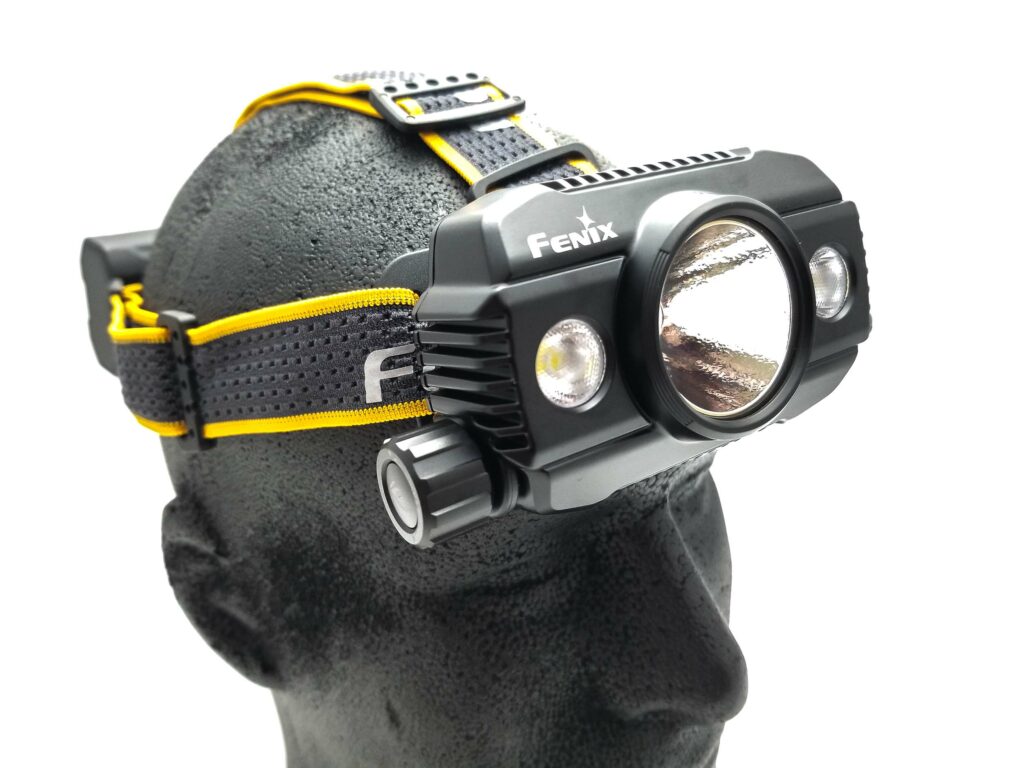
Fenix HP30R V2 specs
| Brand & Model | Fenix HP30R V2 |
|---|---|
| Flashlight category | Multipurpose Headlamp |
| LED | 1*Cree XHP50.2, 2*Cree XP-G3 |
| Max. output | 3000 lumens max |
| Max. beam distance | 270 meters max |
| Max. beam intensity | 17,933 cd |
| Battery config. | 1* 21700 |
| Onboard charging | USB type C |
| Main modes | 4 |
| Blinkies | None |
| Waterproof | IP68 |
| Review publication date | October 2023 |
Review intro:
1Lumen readers know Fenix as a familiar face here, and we’ve reviewed a bunch: Tactical, general purpose, EDC, keychain, utility, and headlamps. I’ve reviewed a bunch of headlamps; some good ones, some great ones, but none like the one on deck for review today, the Fenix HP30R V2. This is quite a special headlamp, and it fits into a special niche not occupied by many others. The specs tell the tale: 3000 (combined) Lumens, 250+ meters throw, remotely-mounted 2×21700 battery back with PD power bank, and a button-less (more or less) rotary switch UI. While you can get something like an Acebeam H30 with higher output, this one is all about sustained output and versatility. It’s big, expensive, and awesome! Let’s take a look.
Package quality.
The HP30R V2 is a professional tool, but Fenix packages it like their LR-series searchlights, in a sturdy, fancy-pants lift-off lid box. It’s slathered with feature blurbs, specs, and attention-grabbing graphics. Inside, all the components are nicely arranged in foam cut to fit. Here’s what’s inside:
- Fenix HP30R V2 headlamp
- 2 Fenix ARB-L21-5000 5000 mAh 21700 batteries (loaded in the battery holder)
- Battery holder/pack
- Belt clip for the battery holder
- Manual
- Warranty card
- USB type C charging cable
- 4 cable clips/organizers
- 3 helmet/hard hat clips
- Extension cable
- Spare o-ring
- Headband with mount
This is an extremely comprehensive kit with everything needed and ready to use. Out of the box, the batteries are sufficiently charged to work, but you’d want to fully charge them. Make sure to open the battery holder and remove the two insulators first!
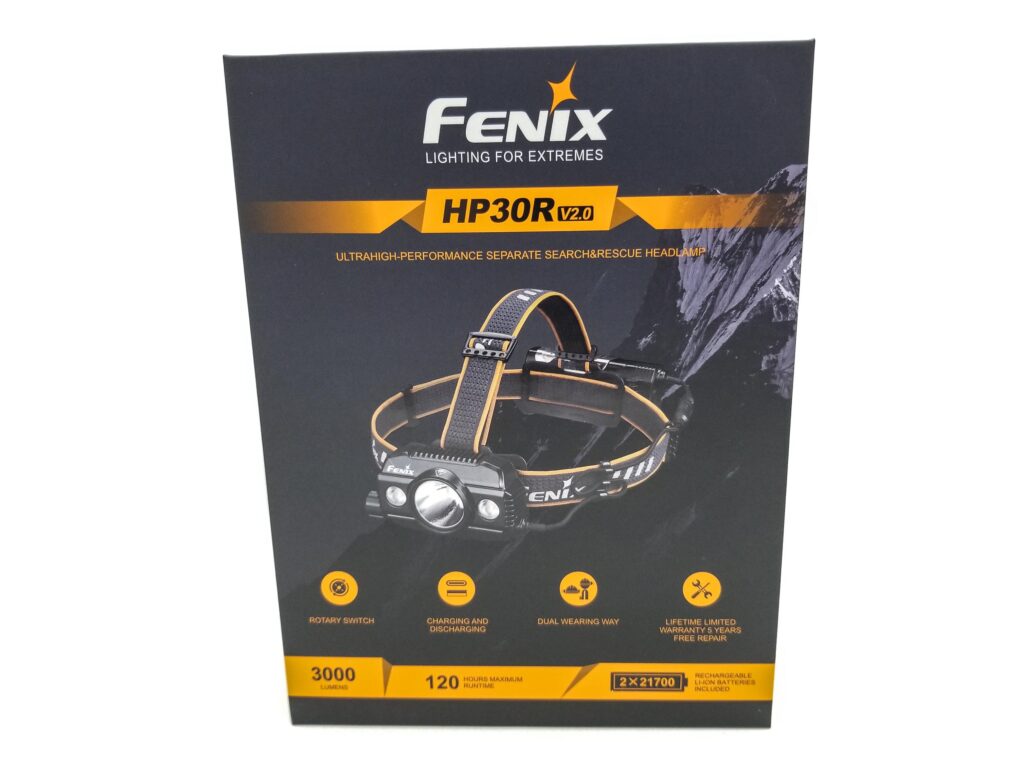
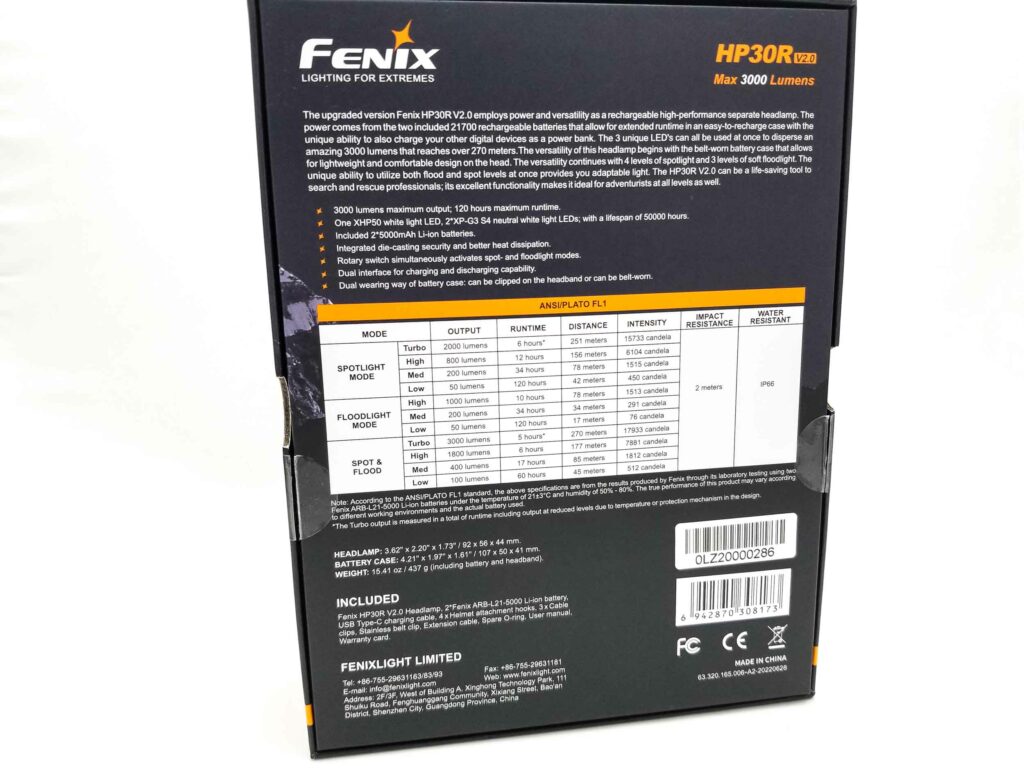

Flashlight in use
As far as headlamps go the HP30R V2 fits into a special niche, namely the utility/searchlight category. This is a high output, fairly long range headlamp with a dual-spot/flood beam setup. 2000 Lumens is available from the spotlight, and 1000 Lumens from the floodlights, and combined there should be around 3000, so there’s a lot of light at your disposal here in addition to longer runtimes and higher sustained output.
You could use it for general purpose, outdoor inspection, search and rescue, camping, spelunking, or exploring.
However, for bumping around the house, it’s a bit overkill since it’s big, bulky, and heavy. Fenix’s excellent headband is included here, with a strap for stability (trust me, it needs it). The headlamp body is affixed (it cannot be removed) to a mount that adjust up to 90 degrees downward with nicely detented, solid clicks.
Out back, there’s another mount for the battery holder. It clips into the mount easily, or it can be mounted remotely thanks to the stainless steel holder with a super-sturdy, wide belt clip. Believe me, this thing clips on and hangs on like John Force hangs on in a funny car crash. Attaching the long remote cable allows for remotely mounting the battery. This is beneficial in cold climates since you can keep the batteries close to your body to keep them warm for optimum performance.
The battery pack can also double as a power bank to charge your phone or other devices. The lighting modes/brightness settings are controlled by a rotary switch mounted to the side of the headlamp. It allows instant on/off and easy control of the spot/flood lighting modes. It has deep scallops in the knob for sure grip even with gloved hands, and a great feel with sharp detented clicks, so accidental mode changes are unlikely. There’s a button in the center to control the flood/spot combination modes. It’s a very nice switching solution I haven’t seen on other headlamps (no press-and-hold for on/off!).
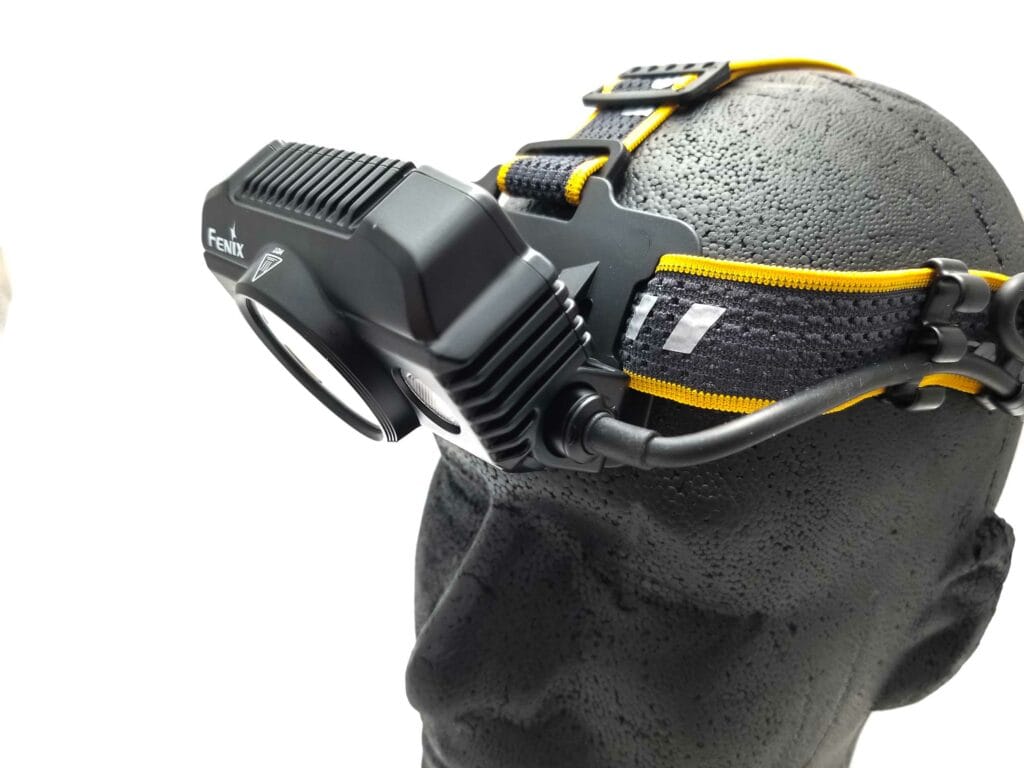

Build Quality and Warranty
This is where the rubber meets the road for professional lighting tools. The HP30R V2 is a very high quality item with a very high price tag of around $220. That’s expensive, and puts it out of reach for most buyers, but for those who need something like this will gladly pay for it. The only real competitor is the Magicshine MOH55 Pro, which I reviewed back in 2021 (excellent, by the way), which retails for around $240.
The build quality is fantastic, as expected at this price point. All the parts fit just fine, no gaps, no oddball angles. It passes the creak test and the maracas test easily. The housing is two pieces of 6061-T6 aluminum that’s joined together with screws. It’s solid, and this iis excellent for heat dissipation and durability. The battery pack is made from high impact ABS plastic. It’s very sturdy and the battery door retention clip seemed durable also. It has a swing out locking bail to secure the cover. With the stainless steel belt clip affixed, the battery back is very well protected.
The machining and finishing is perfect, and all the edges are knocked down and smoothed. The anodizing is semi-gloss black type III HA, and I’d bet it’s close to the true MIL-A-8625 thickness. It’s very nicely done. The cable from the battery pack to the headlamp and the extension cable are very tough, but not the most flexible I’ve encountered and a bit stiff. They’re probably a thermoplastic rubber, which may get more rigid when cold. The connections between the extension cables and inputs are fully shrouded and weatherproofed to keep out detritus and moisture. All the ingress points are sealed with rubber seals or o-rings (the bezel for the flood light), and Fenix gives the HP30R V2 an IP66 rating, so not the better IP68, but it would still withstand drops from 1 meter and shrug off torrential downpours.
Warranty? From Fenix Lighting: 15 days free replacement: Fenix will replace a new product within 15 days of purchase for any manufacturing defects if problems come into being in normal use; We will replace it with the same model. If the model has been discontinued, customers will receive a product with similar or improved model.5 years free repairs: Fenix will offer free repair within 5 years for lights from the date of purchase if problem develops with normal use. Different warranty period for different products:
• Flashlight, Headlamp, Bike Light and Camping Lantern (without a built-in battery) – 5 years (excludes rechargeable battery)
• Flashlight, Headlamp, Bike Light and Camping Lantern (with a built-in battery) – 2 years (battery included)
• Rechargeable battery, battery charger, bike mount, remote pressure switch – 1 year
Except the products and accessories listed above, other products or free offers provided by Fenix are not covered within the product’s warranty. Limited Lifetime Warranty: For lights past the free repair warranty period, we provide lifetime repairs but will charge for parts. Fenix Lighting LLC will notify customer the cost of the part before repair. Please note, due to changing technology, not all older lights will be able to be repaired due to parts not being available. In such cases, Fenix Lighting LLC may provide a discount to the customer for the purchase of a newer model.
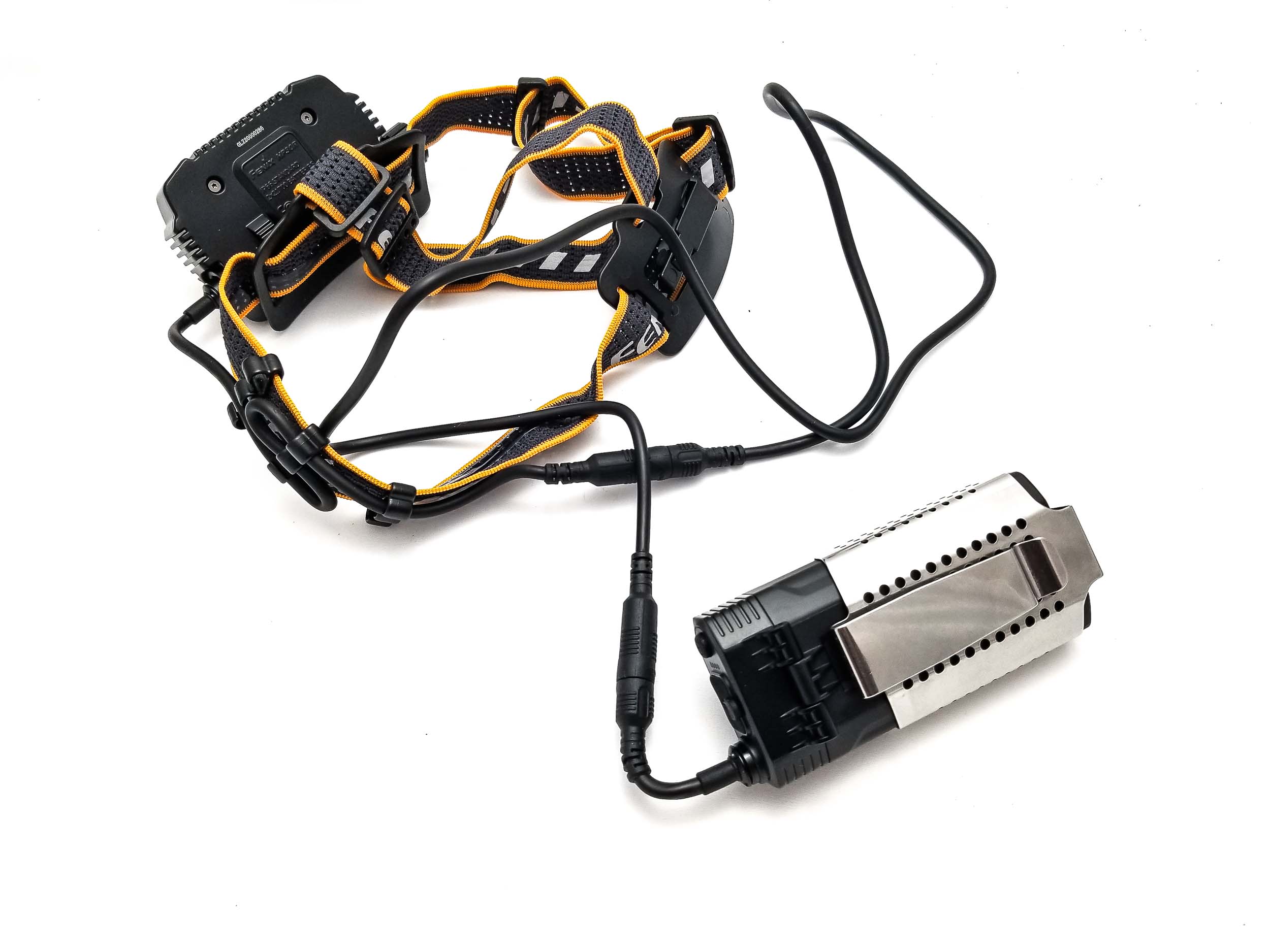
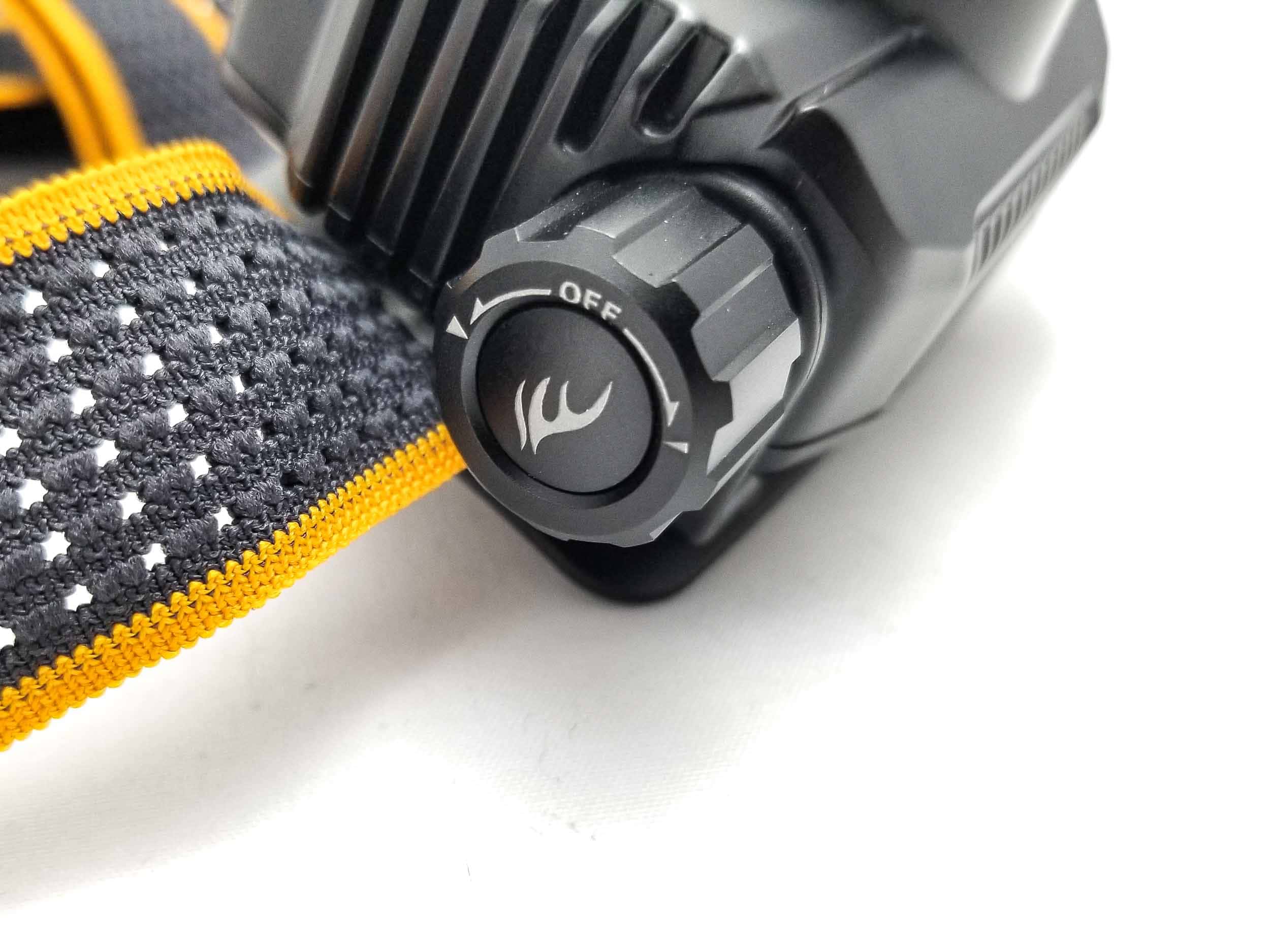
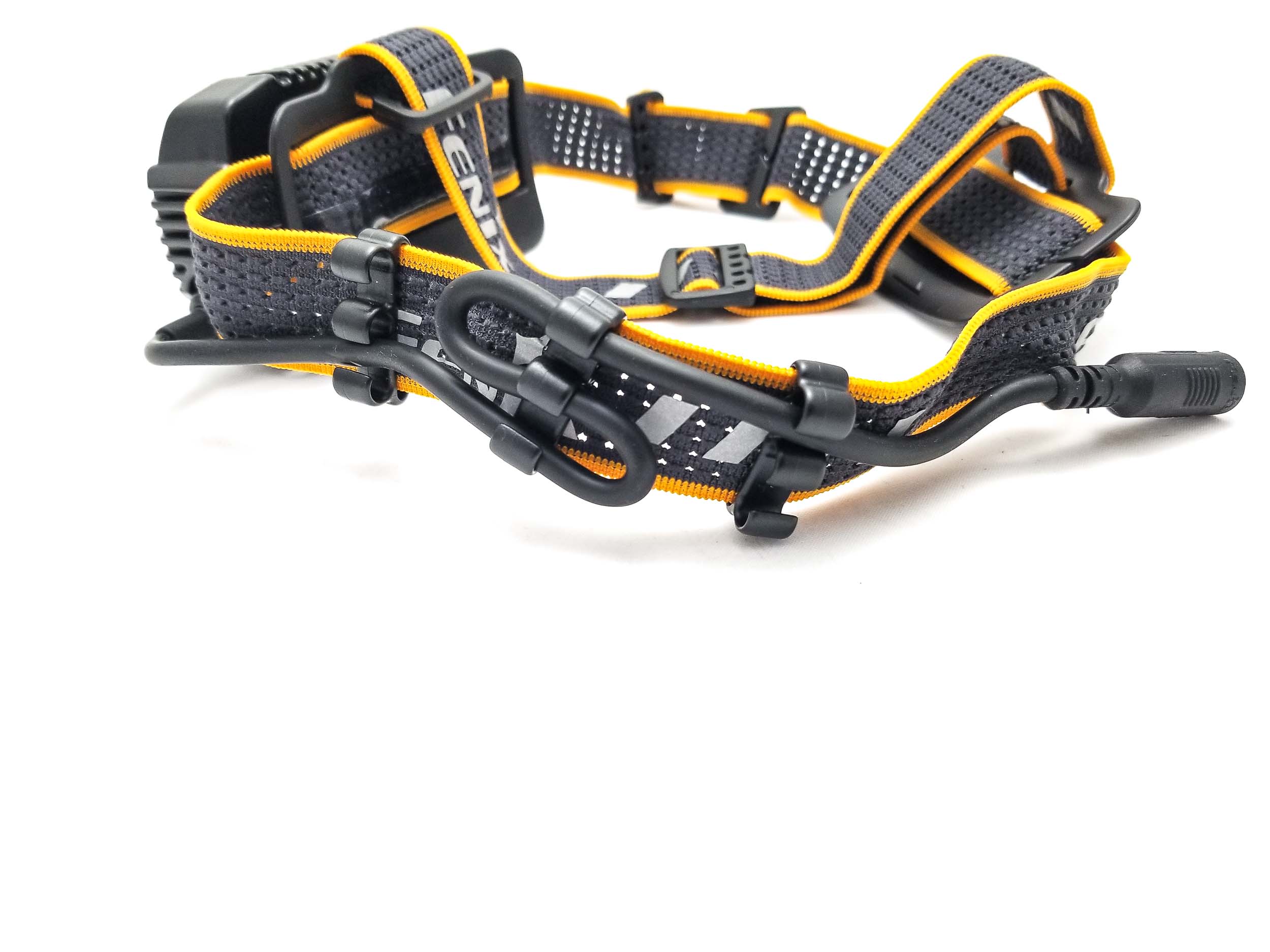
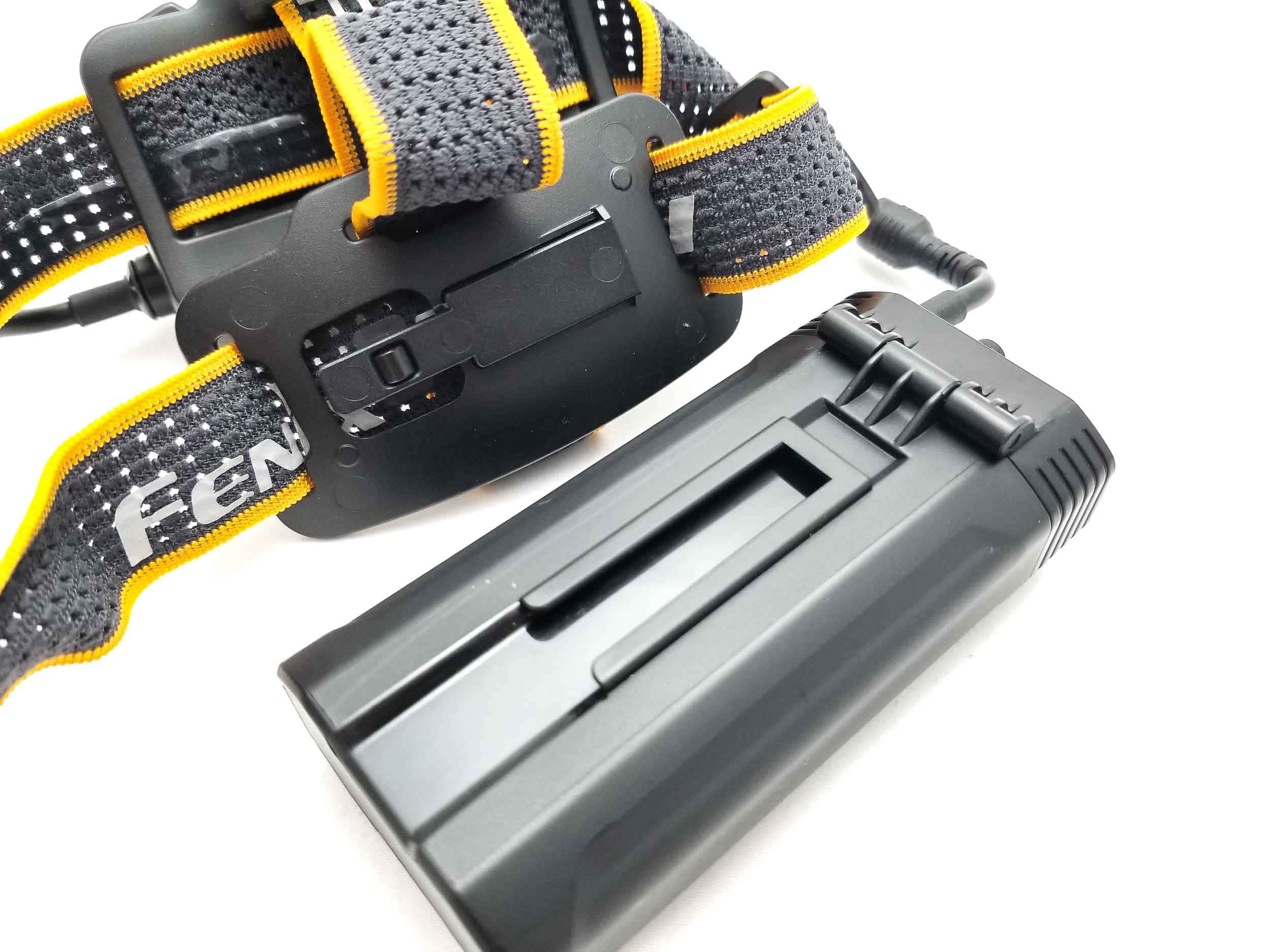
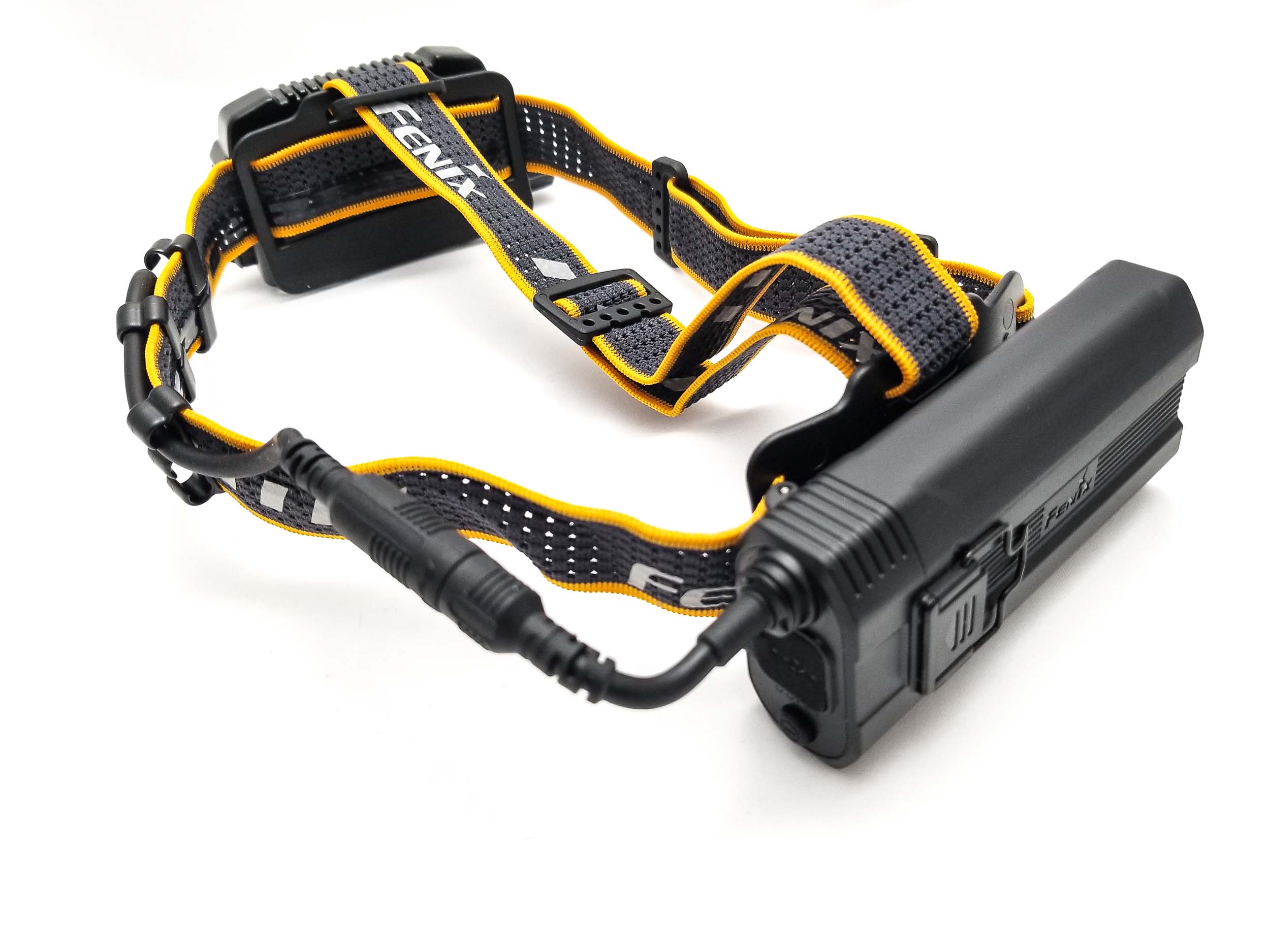
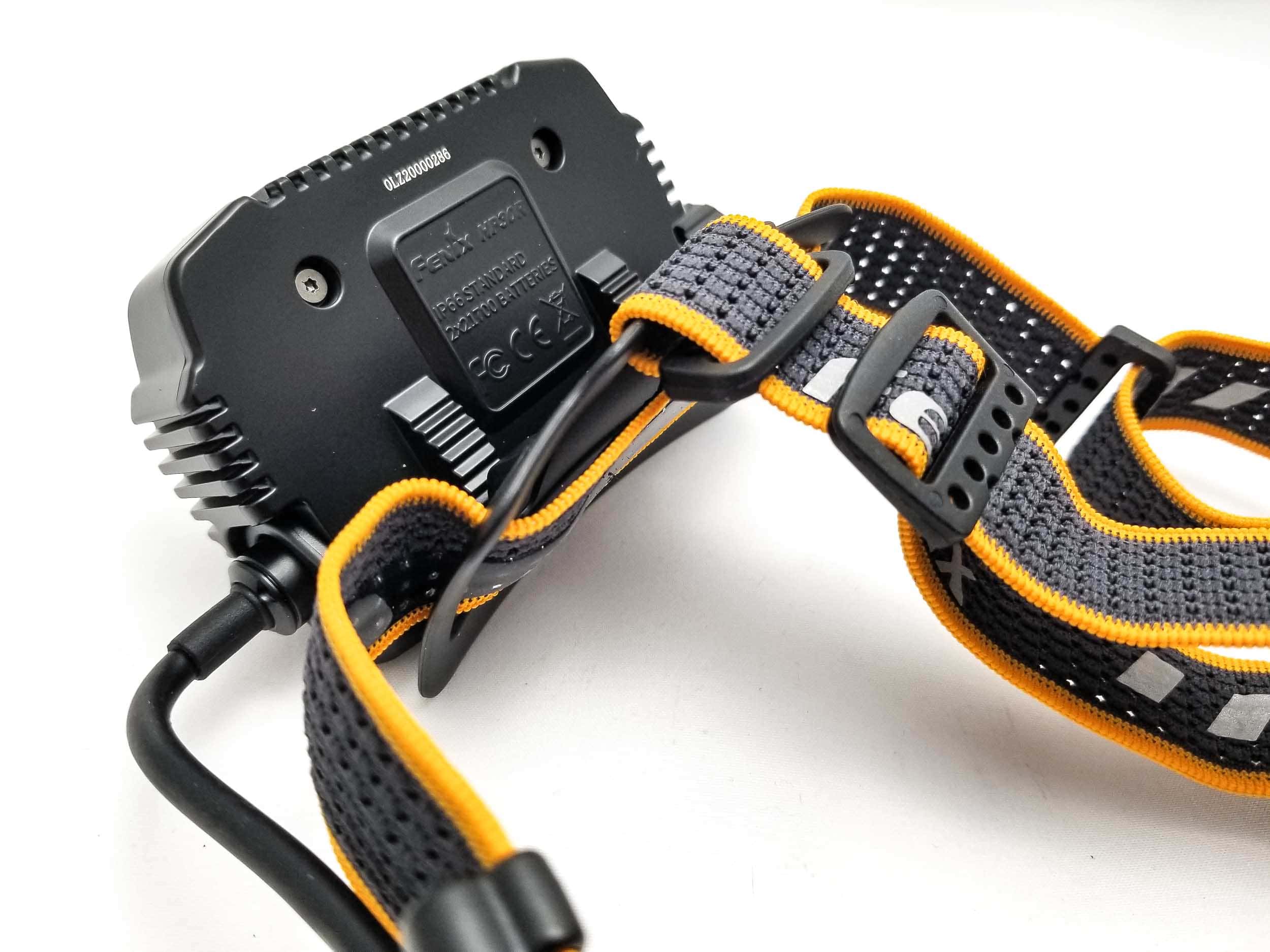
LED, Lens, Bezel, Beam, and Reflector
To achieve the high output spot and floodlight functionality, Fenix went with the old standbys for high output, energy efficient LEDs with the HP30R V2. The spotlight employs the Cree XHP50.2 LED. This is a quad die high output LED that comes in 3, 6, or 12 volts. It’s capable of very high output, and a very common LED for handheld flashlights and has proven itself over and over again. It’s since been replaced by the gen. 3 XHP50, but the gen. 2 is still alive and kicking. The XHP50.2 sits in a roughly 40 mm light orange peel reflector topped by a hardened mineral glass AR coated lens.
The bezel is integrated with the housing. It sticks up a couple millimeters to protect the lens from impacts. The spotlight produces a beam with a smooth transition from the simple spill to a somewhat focused hotspot. The textured reflector helps mitigate the tint shift and generally ugly beam the gen 2 XHP LEDs produce. Flanking the spotlight are the two floodlight LEDs. Fenix specs CREEs for these also, the XP-G3 S4. These are 3535 size LEDs and the gen. 3 XP-G’s are very efficient, high output LEDs. The S4 bin is supposed to be neutral white.
They’re situated behind textured TIR lenses for a nice amount of flood and a smooth beam with no discernable hotspot.
The Opple Lightmaster Pro has the XHP50.2 coming in at CCT 6246K and CRI Ra 68.7 with a duv of 0.0032.
The XP-G3s are coming in at a pretty neutral CCT 4877K and CRI Ra 69.7. The duv is 0.0020.
I was surprised Fenix didn’t use the high CRI version of the XP-G3 (which goes up to 90 CRI in 4500 or 4750K). I think I would have preferred those. I digress though since this combination would be excellent for a variety of lighting scenarios.
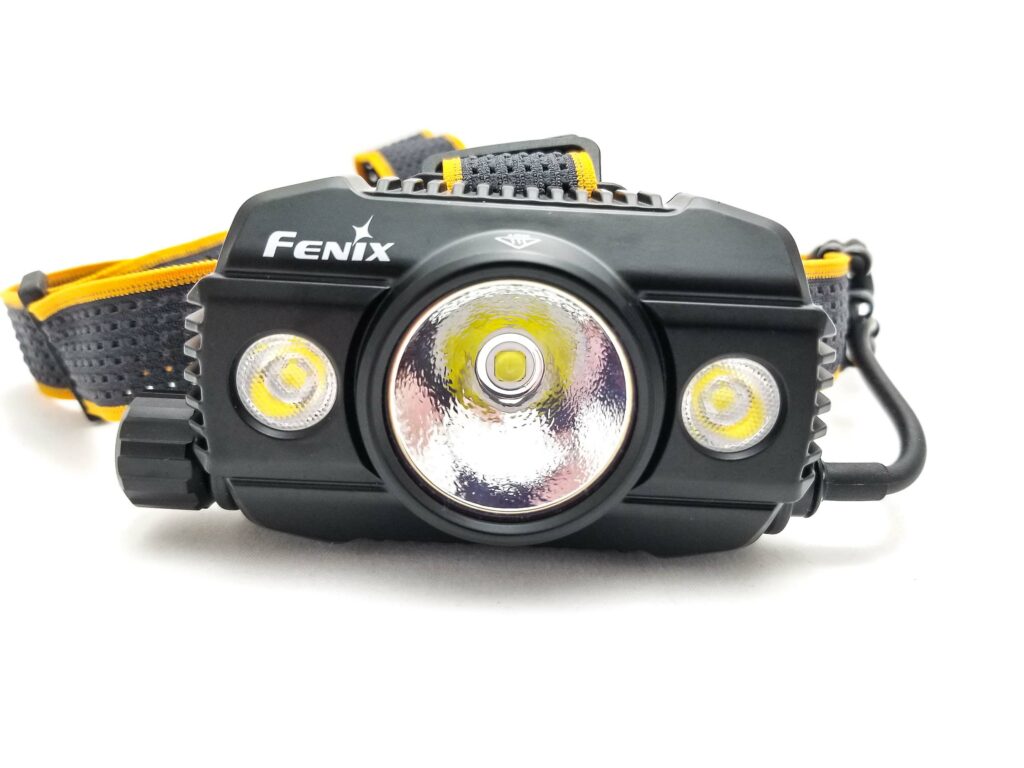
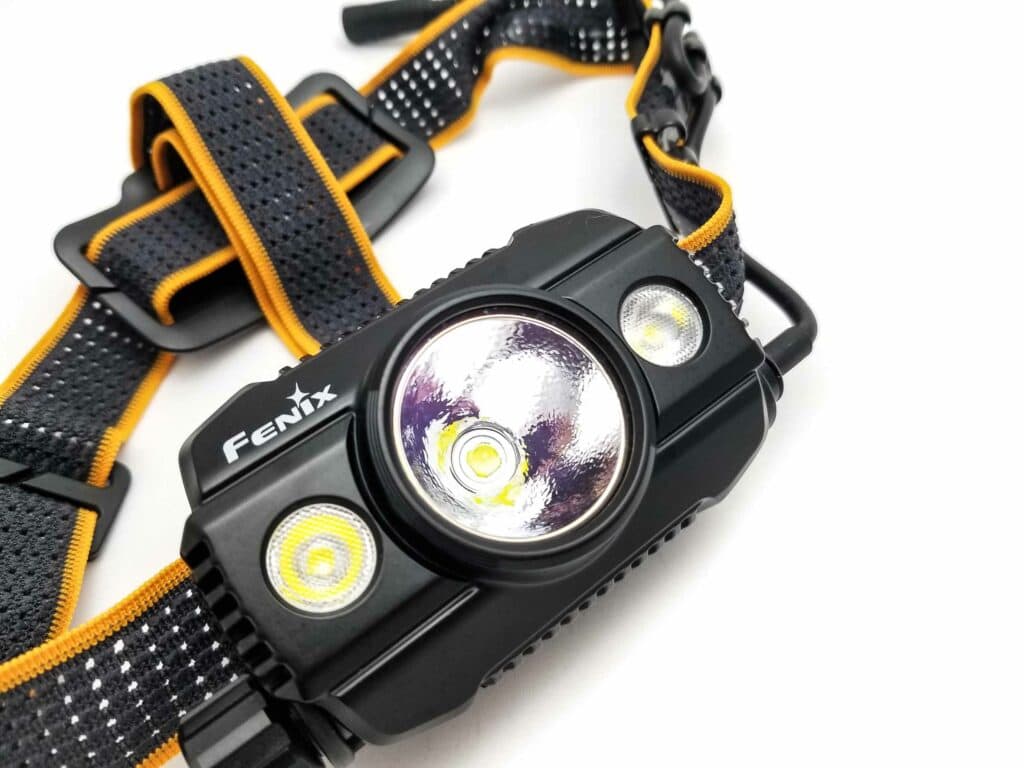
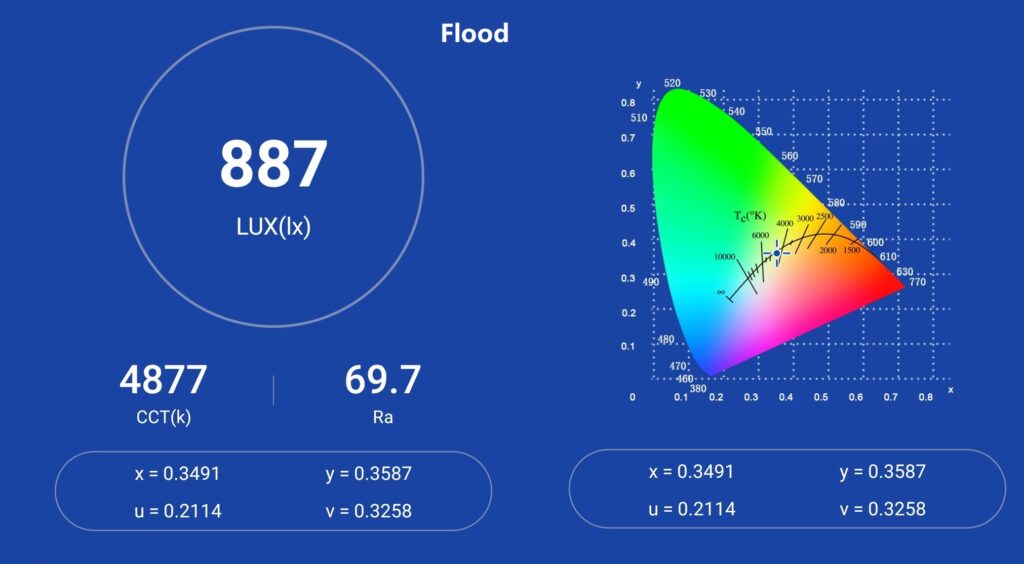
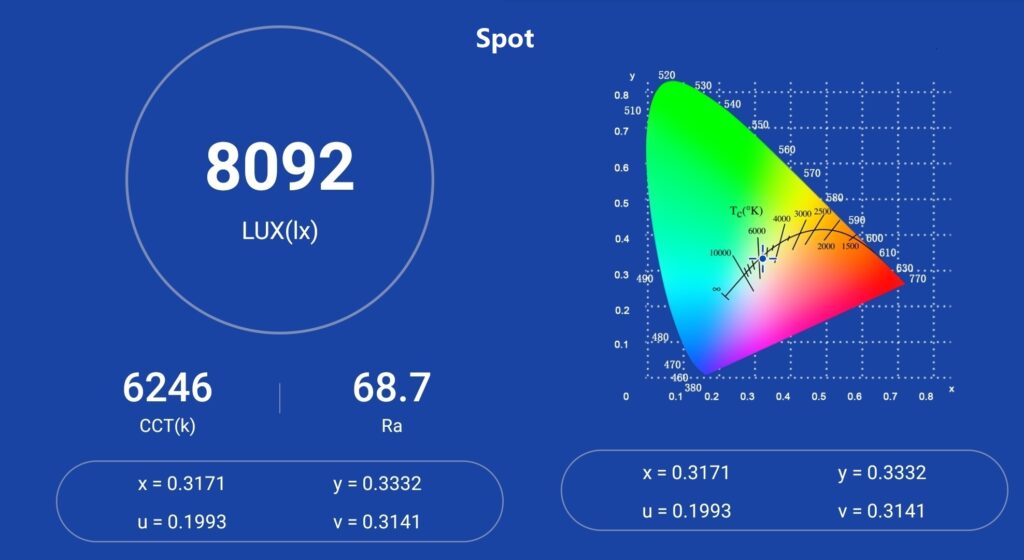
Dimensions and its competition
Dimensions:
| Fenix HP30R v2 | Millimeters | Inches |
|---|---|---|
| Housing Length | 92 mm | 4 in |
| Housing Width | 56 mm | 1.3 in |
| Housing Diameter | 44 mm | 1.7 in |
| Spotlight Bezel Diameter | 26 mm | 1 in |
| Battery Case Length | 107 mm | 4.2 in |
| Battery Case Width | 50 mm | 1.9 in |
| Battery Case Thickness | 41 mm | 1.6 in |
Dimensions are rounded to the nearest millimeter, and to the nearest tenth of an Inch.
Weight:
| Fenix HP30R v2 | Weight in grams | Weight in oz |
|---|---|---|
| With headband no batteries | 298 g | 10.5 oz |
| With headband+batteries | 537 g | 18.5oz |
Weight is rounded to the nearest gram, and to the nearest tenth of an Oz.
This is a heavy headlamp. With the battery pack and the batteries, it’s over 1 lb (0.52 kg), but it didn’t feel that heavy when I was wearing it and using it. The design of the strap and headband minimized the felt weight nicely.
Headlamp size comparison with its competition:
Compared to some of the best headlamps.
Group 1: Magicshine MOH55 Pro Aguila, Fenix HP30R V2
Group 2: Fenix HM70R, Fenix HP30R V2
Group 3: Slonik (aka Boruit) D10, Fenix HP30R V2
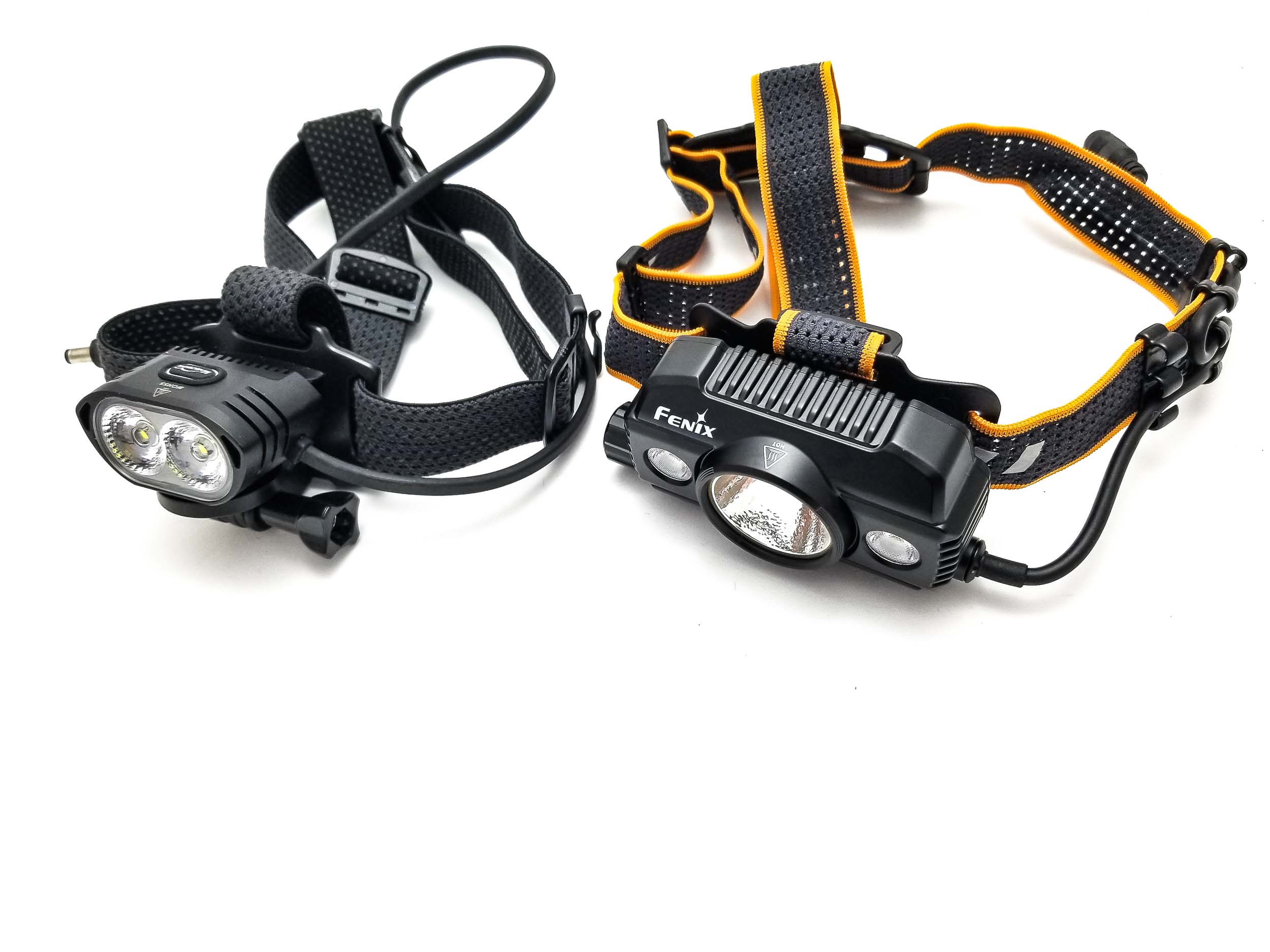
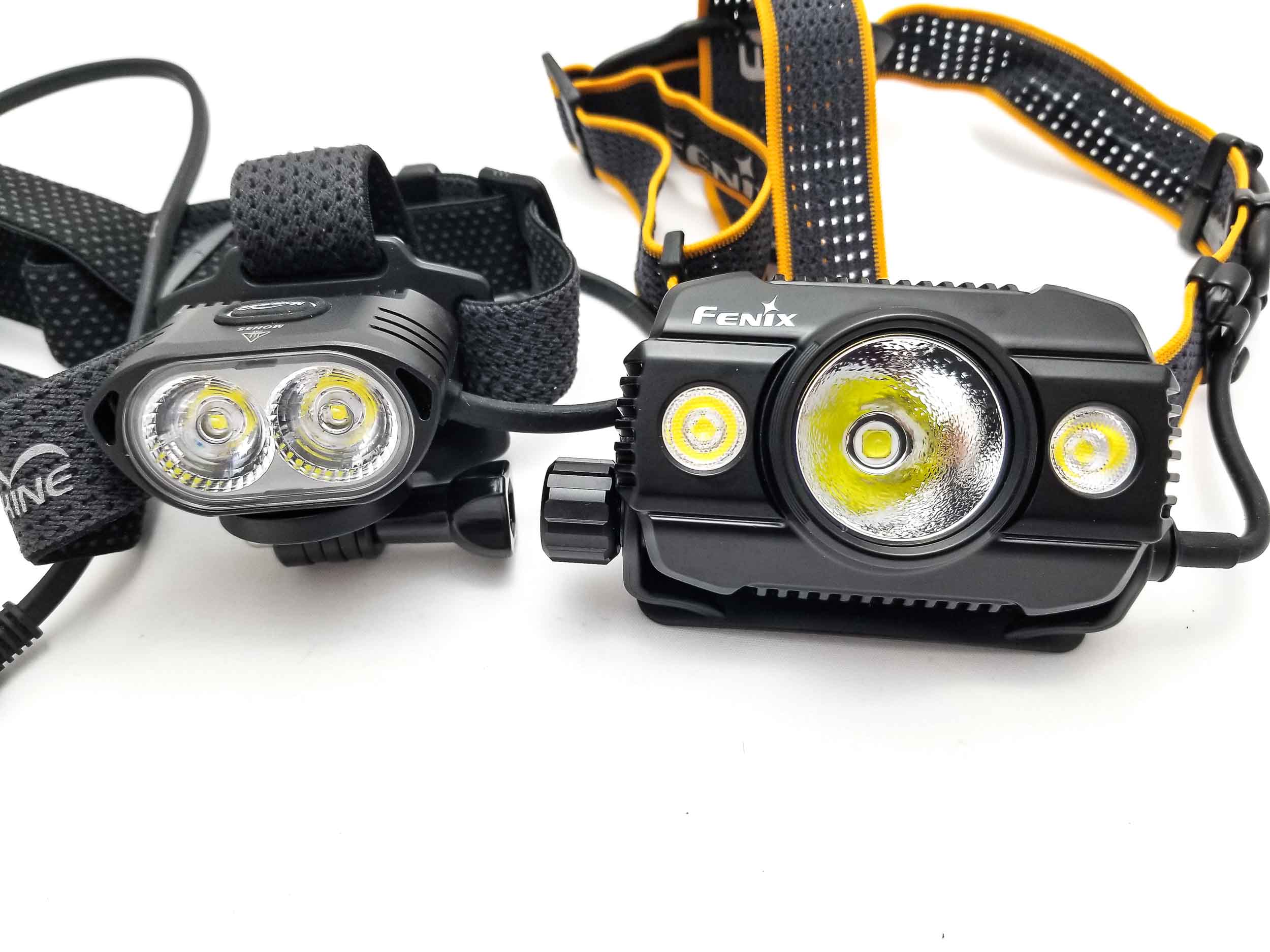
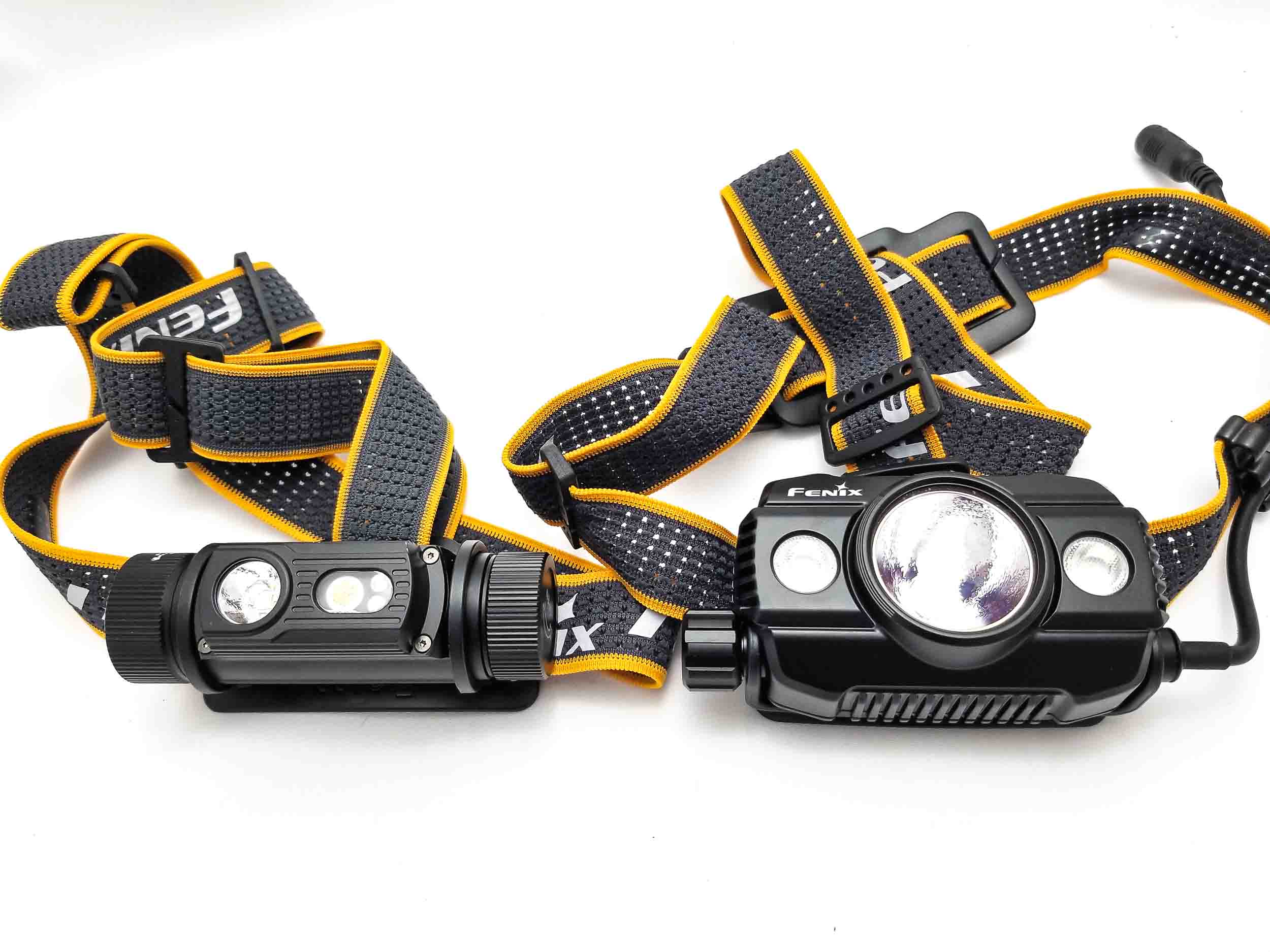
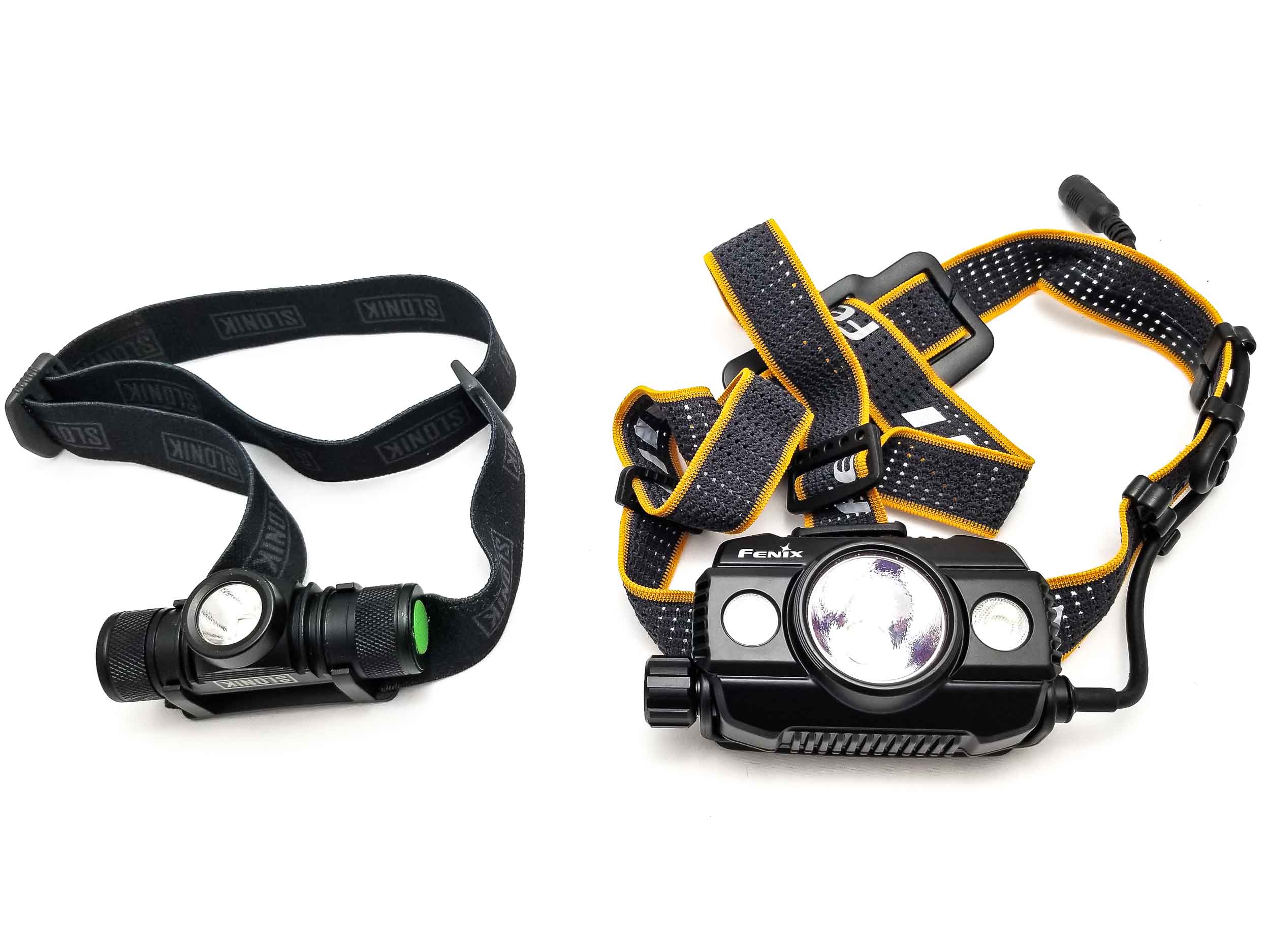
Fenix HP30R V2 UI: User Interface and Driver
I can’t say for sure what kind of electronics are hiding in the housing, but it’s probably going to be a constant current, fully regulated driver that powers the flood and spotlights. Since the input voltage is 8.4 volts (2S), there has to be a buck circuit in there somewhere, and my guess these are all 3 volt LEDs. On professional-use lights, fully regulated drivers are essential for continuous, laminar output that isn’t affected by battery voltage (until the driver drops out of regulation).
For the UI, Fenix pulled a rabbit out the hat with this one. It’s all-new for the HP series and instead of traditional buttons for controlling the lighting modes and brightness levels like everyone else is doing, they’ve gone with a rotary dial with a center switch. It’s s super simple and highly effective solution (genius, really) for this headlamp. Turn the switch clockwise to control the spotlight modes, counterclockwise for the floodlight modes. Clicking the center switch will activate the spotlight and floodlight modes simultaneously, and rotating the switch will control the combined brightness levels. See, I told you it was easy.
Available modes:
- Spotlight LED: Low, Medium, High Turbo
- Floodlight LEDs: Low, Medium, High
- Spot and flood LED combination: Low, Medium, High, Turbo
Available blinky modes:
- None
Switching between spot and flood LEDs:
- In spotlight mode, turn the rotary switch counterclockwise
- In floodlight mode, turn the rotary switch clockwise
To activate the spotlight/floodlight combination:
- In any state or lighting mode: Press the switch in the center of the rotary switch. Press again to exit back to Low mode in either spotlight or floodlight
From OFF:
- Turn the rotary switch clockwise: Activates the spotlight mode
- Turn the rotary switch counterclockwise: Activates the floodlight function
From ON:
- In spotlight mode: Turn the rotary switch clockwise to cycle through the brightness levels L,M,H,T. Turn the switch counterclockwise for T,H,M,L
- In floodlight mode: Turn the rotary switch counterclockwise to cycle through the brightness levels L,M,H. Turn the switch clockwise for H,M,L
- To turn off in either lighting mode: Turn the rotary switch until the light turns off after the highest mode
- To activate combined flood & spotlight modes: Click the center switch. Click again to switch back to the last lighting mode
Mode memory:
- None
Shortcuts:
- N/A
Low voltage warning:
- Fenix says there is visual LVP in addition to indicator bars on the battery back. The indicator bars on the battery pack. Click the switch on the battery pack to show the current battery state (NOTE: Fenix says this only works with the included batteries):
- Four solid bars: 100% – 80%
- Three solid bars: 80% – 60%
- Two solid bars: 60% – 40%
- One solid bar: 40% – 20%
- One flashing bar: 20% – 1%
Strobe/blinkies
- None
Lock-out mode:
- None
PWM
- None visible
Additional/summary info on the UI:
- Rotary switch controlled UIs are nothing new for Fenix, but they are for headlamps. For the HP30R V2, the rotary switch is a great idea and I think it works well. It’s a very intuitive way to switch modes, and works well. However it isn’t perfect and there is a learning curve to mastering it if one isn’t used to it. I’m not too bent out of shape about this though because of the advantages of the rotary switch (like using it with gloves, or by feel). You can’t really accidentally switch modes this way either. I like that you can switch between spot and flood and spot+flood on the fly also, with no press and hold nonsense (aint nobody got time for that). You are giving up mode memory with the switch though since on is on, and off is off and turning it on always starts in the lowest mode. This can be good or bad, but I don’t think that is terribly detrimental on a headlamp like this. Fenix says there’s temperature regulation built in, and the LVP has a visual indicator that drops the output very low (to the Low mode) and blinks 3 times every 5 minutes.
Fenix HP30R V2 Charging and batteries
High performance endurance headlamps need a stout power supply and the HP30R V2 delivers with a dual 21700 battery layout. The two 21700s are arranged in series for 8.4 volts. Fenix includes two of their excellent ARB-L21-5000 mAh 21700s. These are a familiar battery included with their ‘R’ (integrated charging) lights. They’re button tops with protection circuits for LVP functionality. Like most Fenix lights, you aren’t limited to the included batteries, as flat top, button top, protected, and unprotected 21700s fit fine (standard flat tops are a bit loose, but still worked-like Samsung 40Ts). However, Fenix warns that the visual LVP functionality doesn’t work if you don’t use the included cells. Similar to other high output headlamps, the batteries are housed in a battery pack that doubles as a power bank.
Swapping the batteries is simple: Open the locking latch, lift slightly on the tab to pop open the cover, and replace the batteries. The pack has a roughly 2.5 inch lead that connects to the headlamp’s input cable when the battery is mounted to the headband. You can attach the extension cable to remotely mount the battery pack to your belt, pack, vest, or web gear. This is a great feature because it allows you to house the battery close to your body to keep it warm in really cold environments because li-ion batteries don’t like cold, and it can affect the output/capacity. There’s a rubber cover on the top of the pack, and flipping it open you find two USB connectors: A standard USB A and a type C input. The type C is the charging input, and the type A is the power bank output.
Fenix doesn’t list a charging current, but says the batteries fully charge in 4.5 hours. The power bank is rated for 5 volts 2 amps output. My USB tester on type C showed 2.54 amps and about 5 volts on the charging input. Switching to the power bank, I charged the battery from the Loop SK01s and got 1.4 amps and 5 volts.
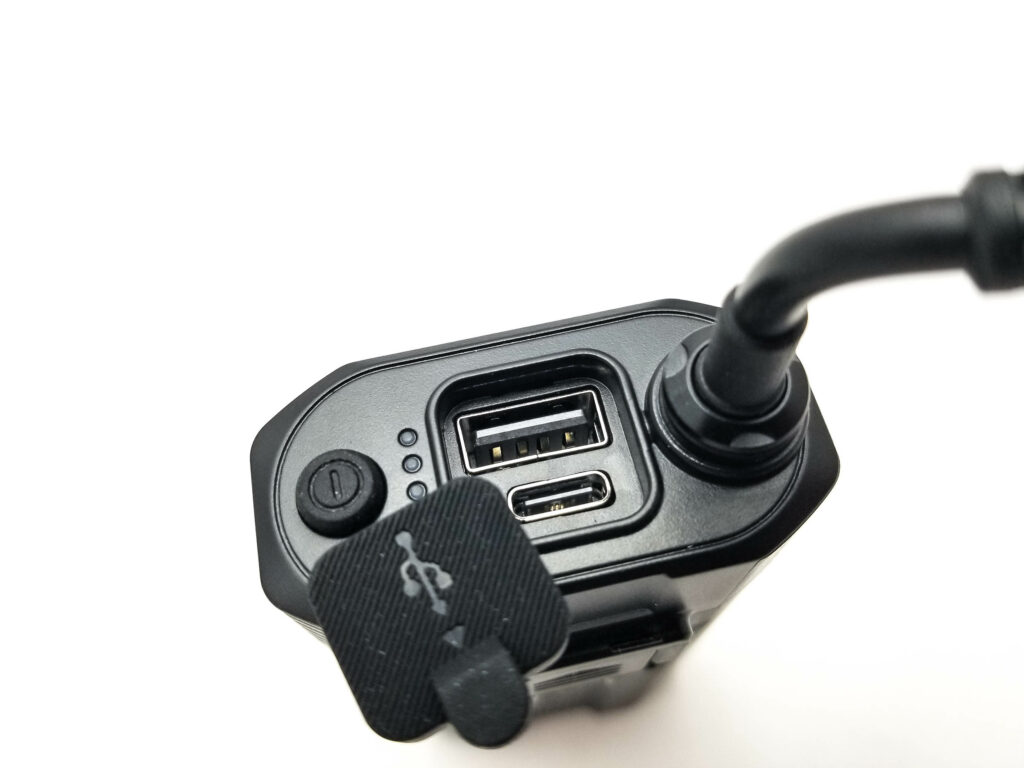
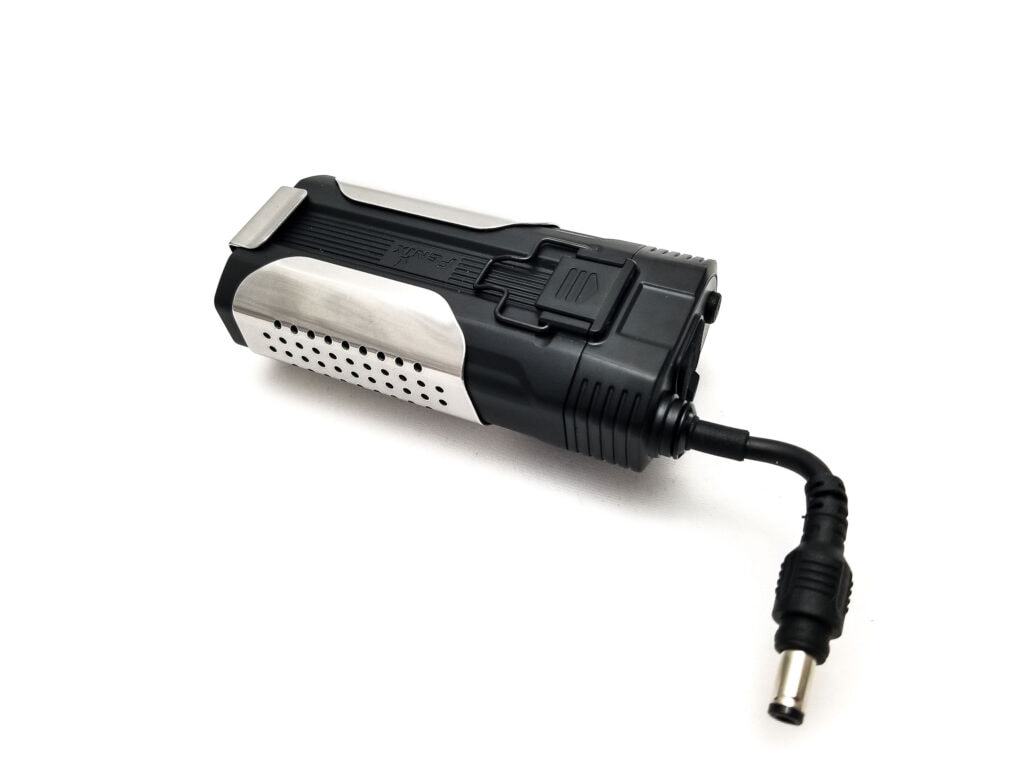
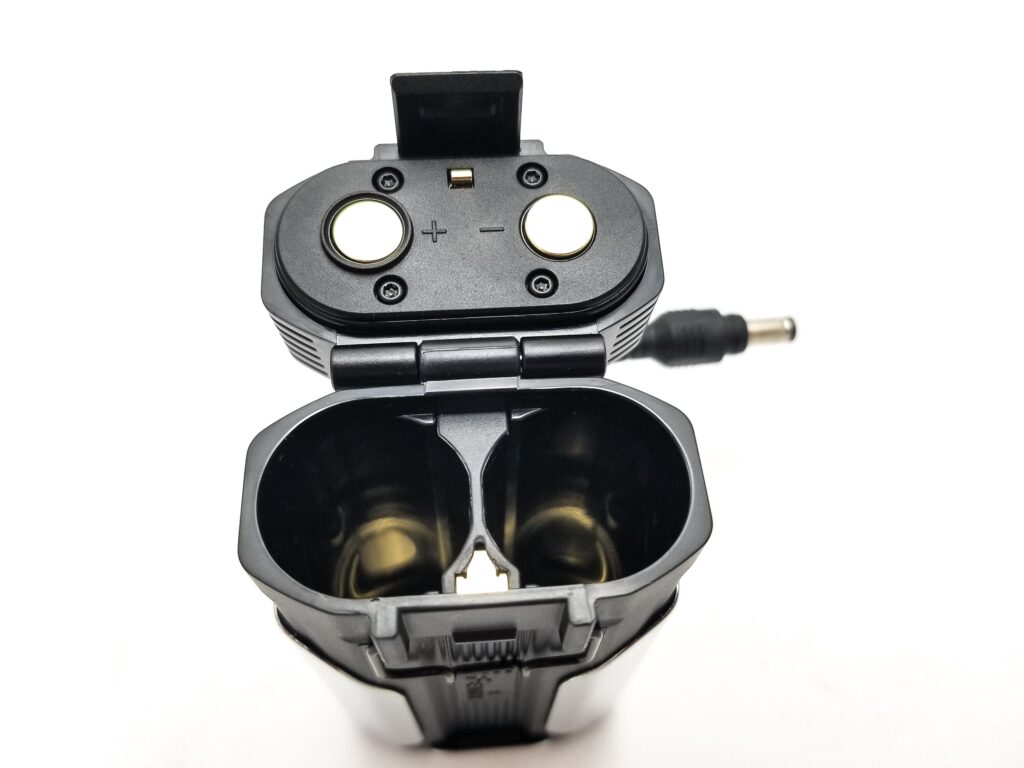
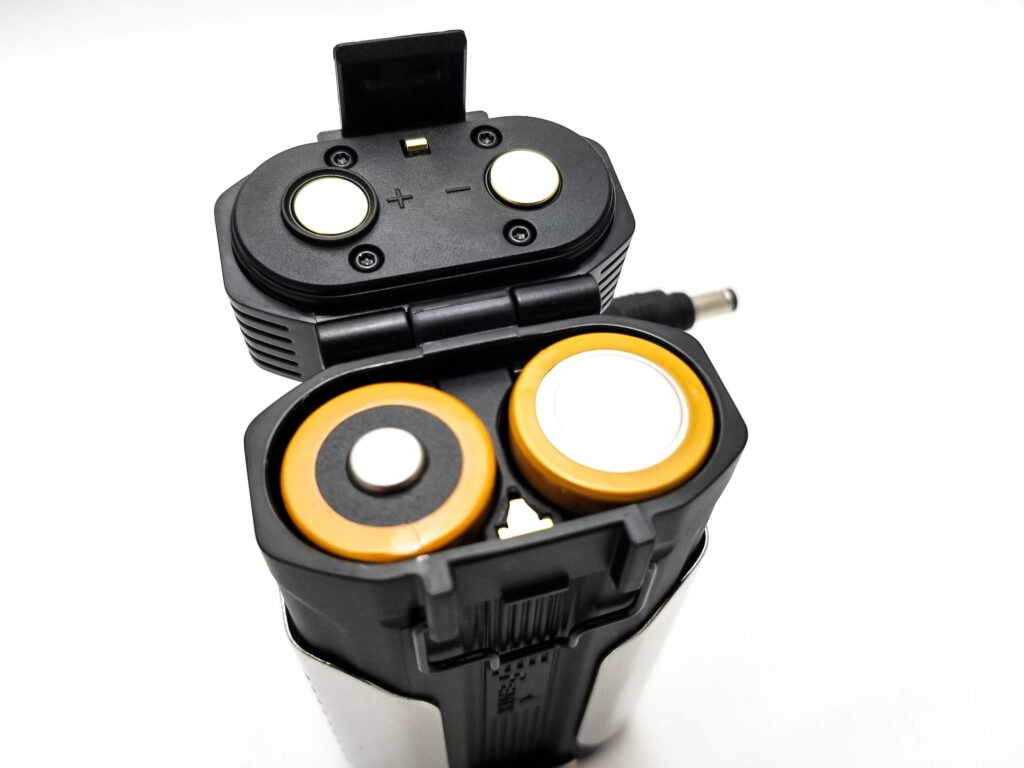
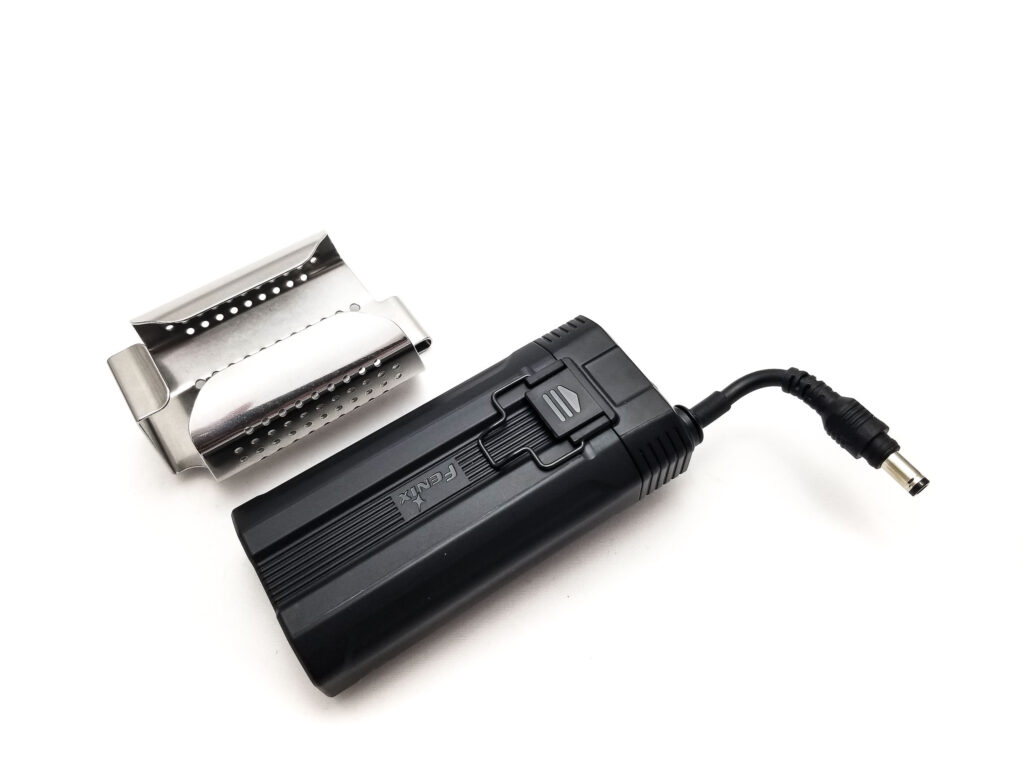
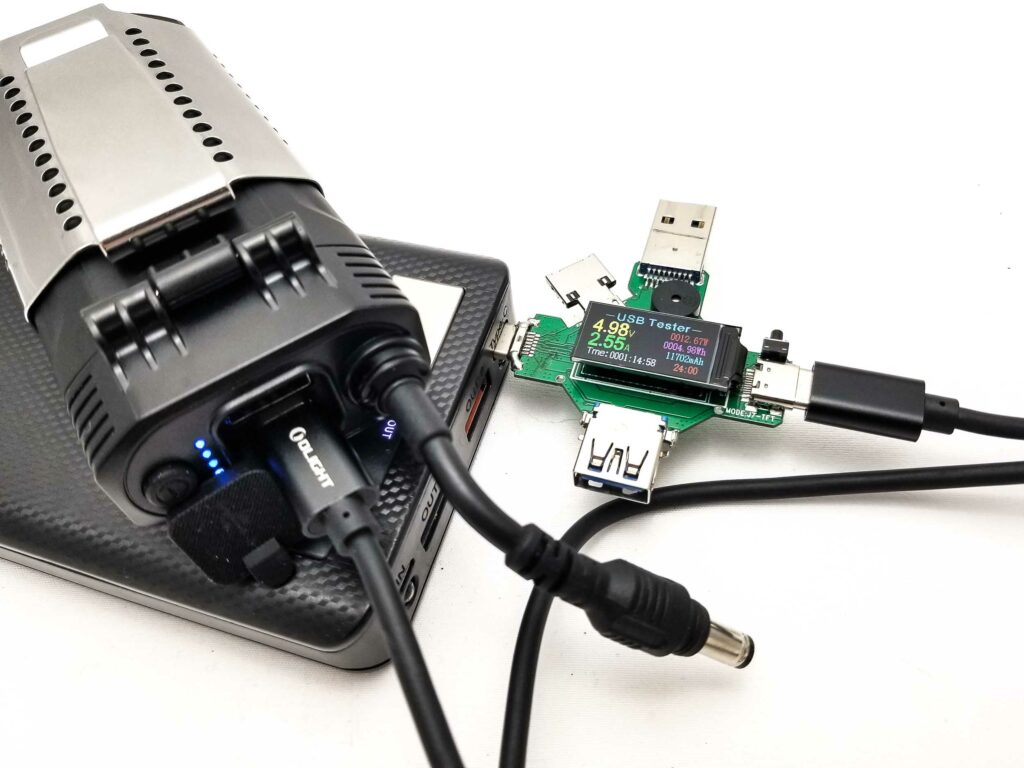
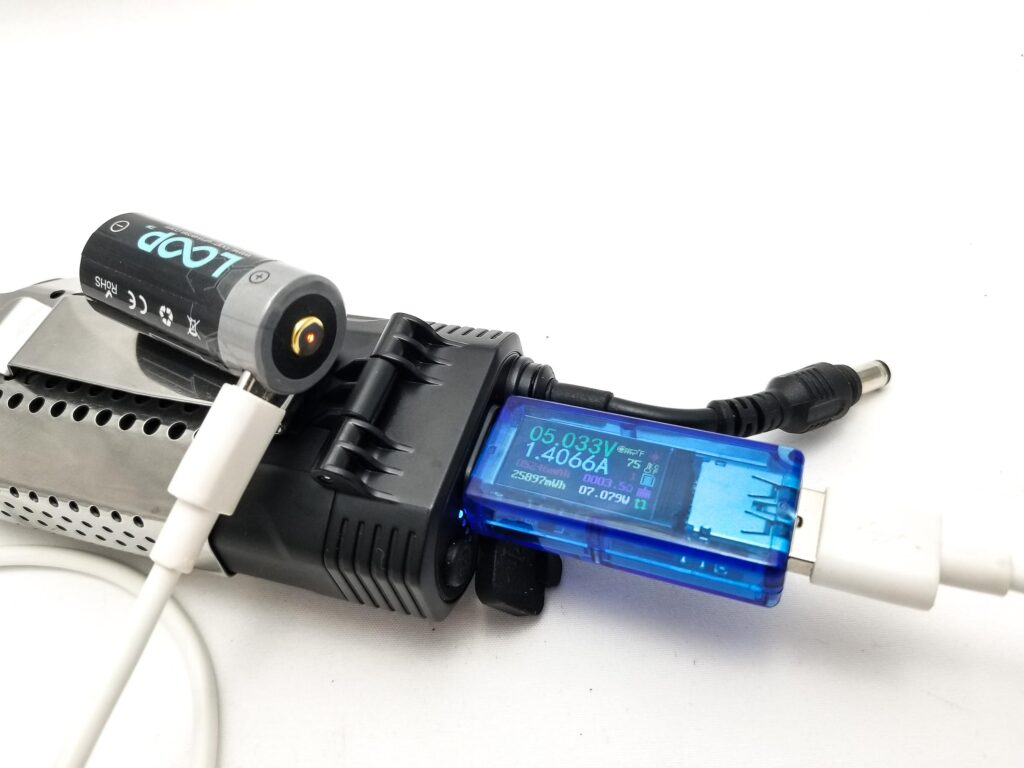
Performance test
Lumen measurements
How Lumens are Measured: Understanding ANSI FL1 Standards How Lumens are Measured: Understanding ANSI FL1 Standards: The ANSI FL1 standards specify that output in lumens should be measured 30 seconds after turning on, as this is the standardized time for measuring brightness according to the industry standard. This is why we focus on this part in our measurements. The ANSI FL1 standards require an ambient temperature of 22 ± 3°C. We record the ambient the ambient temperature to identify potential reasons for any observed discrepancies.Lumens are measured in my integrating tube made from a 4” to 3” closet elbow, two 3” street 90s, and an end cap. I use a Digi-Sense 20250-00 data logging luxmeter. The tube has been calibrated with a Convoy S2+ measured to 260 Lumens. No current measurements this time due to the isolated current path. Temperatures were measured with a Digi-Sense 20250-92 datalogging thermocouple. The temperature probe was affixed to the main housing with kapton tape where I figured was the hottest area. I used the same 5 second sampling as the luxmeter. I used the included fully charged Fenix ARB-L21-5000 mAh 21700s for the test.
| Mode | Specs | turn on | 30 sec | 10 minutes |
|---|---|---|---|---|
| Spot LED | ||||
| Low | 50 | 47 lm | 47 lm | – |
| Medium | 200 | 162 lm | 162 lm | – |
| High | 800 | 676 lm | 667 lm | 643 lm |
| Turbo | 2000 | 1683 lm | 1617 lm | 891 lm |
| Flood LED | ||||
| Low | 50 | 43 lm | 43 lm | – |
| Medium | 200 | 168 lm | 168 lm | – |
| High | 1000 | 861 lm | 838 lm | 792 lm |
| Spot & Flood LEDs | ||||
| Low | 100 | 86 lm | 86 lm | – |
| Medium | 400 | 330 lm | 330 lm | – |
| High | 1800 | 1485 lm | 1452 lm | 825 lm |
| Turbo | 3000 | 2310 lm | 2277 lm | 660 lm |
The integrating tube isn’t optimized for lights that aren’t throwers, so these figures are probably +/-15% on the low side. For a headlamp, this is pretty decent output. Over 1500 Lumens for the main spotlight is pretty good, and the floodlight at almost 900 Lumens is pretty good too! More important is the sustained output. For this type of headlamp, that’s key, and the HP30R v2 excels here.
Fenix HP30R V2 Battery Life: Runtime graphs
How Runtimes are Measured: Understanding ANSI FL1 Standards About ANSI FL1 runtime standards: The runtime is measured until the light drops to 10% of its initial output (30 seconds after turning on). This does not mean that the flashlight is not usable anymore. The last column shows how long the light actually works till it shuts off. If there is a + symbol, it means that the test was stopped at that particular point, but the light was actually still running. This happens on certain occasions, with certain drivers, firmware, or batteries.Lumens are measured in my integrating tube made from a 4” to 3” closet elbow, two 3” street 90s and an end cap. I use a Digi-Sense 20250-00 data logging luxmeter. The sphere has been calibrated with a Convoy S2+ measured to 260 Lumens. No current measurements this time due to the isolated current path. Temperatures were measured with a Digi-Sense 20250-92 data logging thermocouple. The temperature probe was affixed to the main housing with kapton tape where I figured was the hottest area. I used the same 5 second sampling as the luxmeter. I used the included fully charged Fenix ARB-L21-5000 mAh 21700s and tested High and Turbo modes for spotlight, High for the floodlight, and Turbo and High for the spot+floodlight. The Medium modes run a very long time so I didn’t test those.
| Mode | Specified runtime | Measured runtime ANSI | Time till shut off |
|---|---|---|---|
| Spot LED | |||
| High | 12h | 9h 20m | 9h 20m |
| Turbo | 6h | 6h 35m | 7h 16m |
| Flood LED | |||
| High | 9h 30m | 10h 12m | 15h 40m |
| Spot and Flood LEDs | |||
| High | 6h | 6h 18m | 7h 1m |
| Turbo | 5h | 5h 36m | 6h 2m |
Cramming all that power into a compact headlamp body is going to necessitate either aggressive thermal throttling, or output throttling, and no surprise, Fenix implemented output throttling here. There;s the standard step down from Turbo and High on both lighting modes, and both Turbo and High modes employ throttling as the output fluctuates actively after about 5 minutes for Turbo spotlight and later for the other modes. The High Spotlight and Floodlight combination mode starts throttling well into the runtime. It looks dramatic on the graphs, but it is imperceptible in real life and I didn’t notice any fluctuations in brightness during the testing. The aluminum housing does heat up during the high and turbo tests, but I only saw a max of 50-52 C during those tests. The output is overall extremely consistent with constant brightness throughout the runtimes. The output gives more than enough light for most tasks indoors and outdoors. Towards the end of the runtimes, the light stepped down very low and eventually shut off. Once the LVP shut the light down, it couldn’t be reactivated, but you had plenty of warning with visual LVP blinks coming beforehand. The batteries read between 2.8 and 3 volts after each test. I’d have no issues taking the HP30R V2 on an extended spelunking session or search and rescue mission.
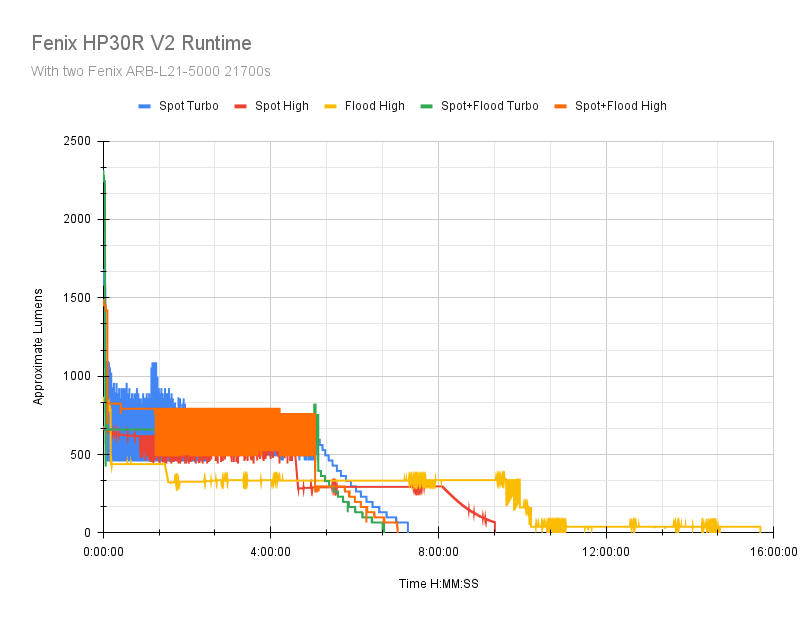
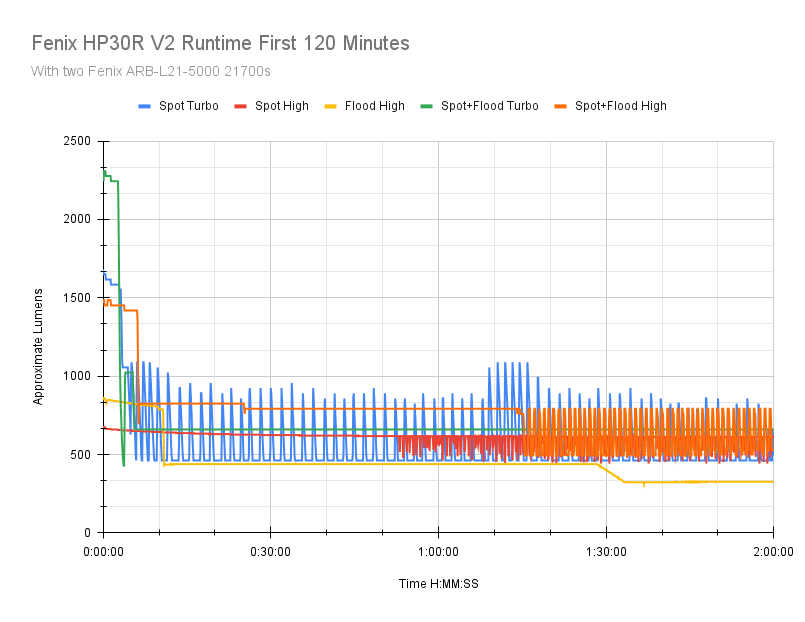
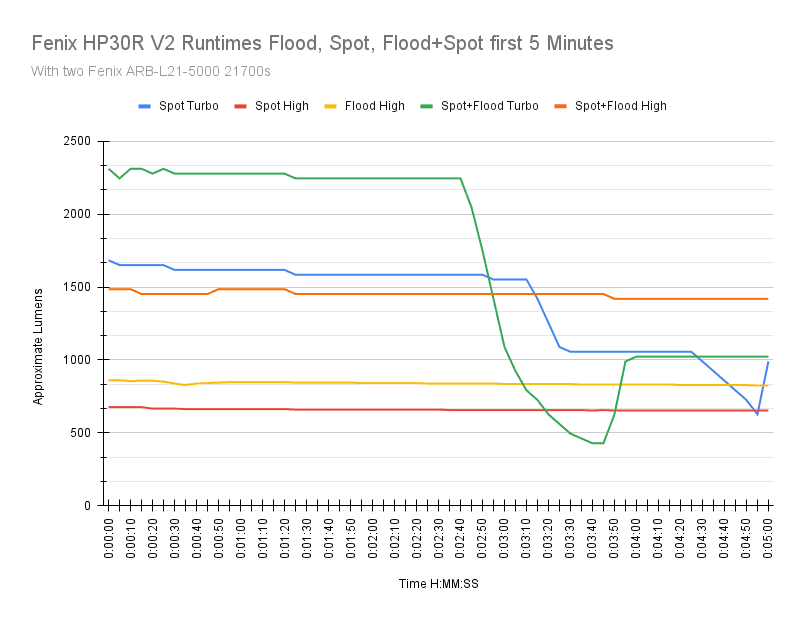
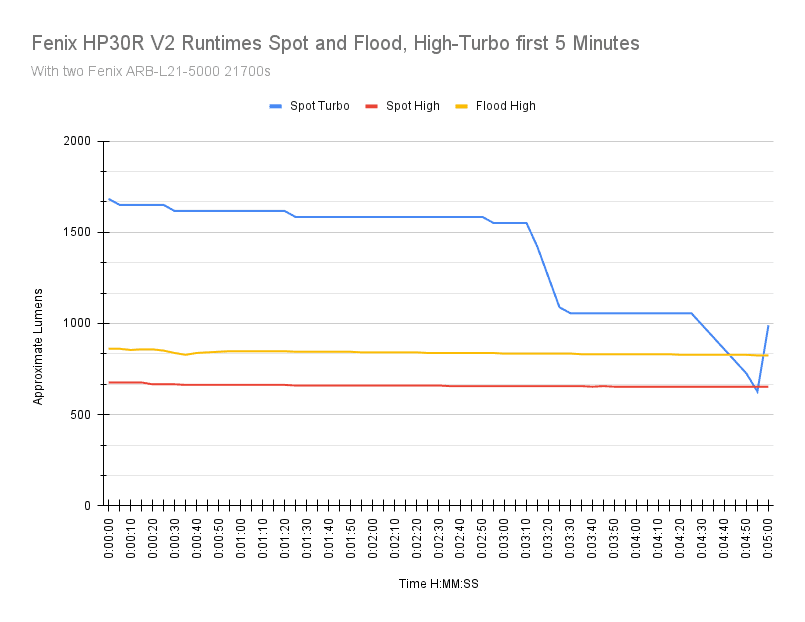
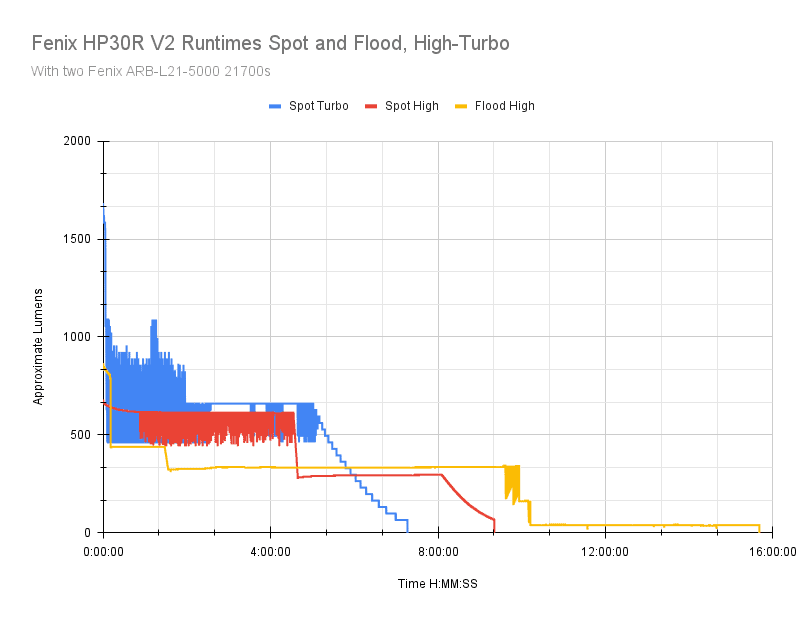
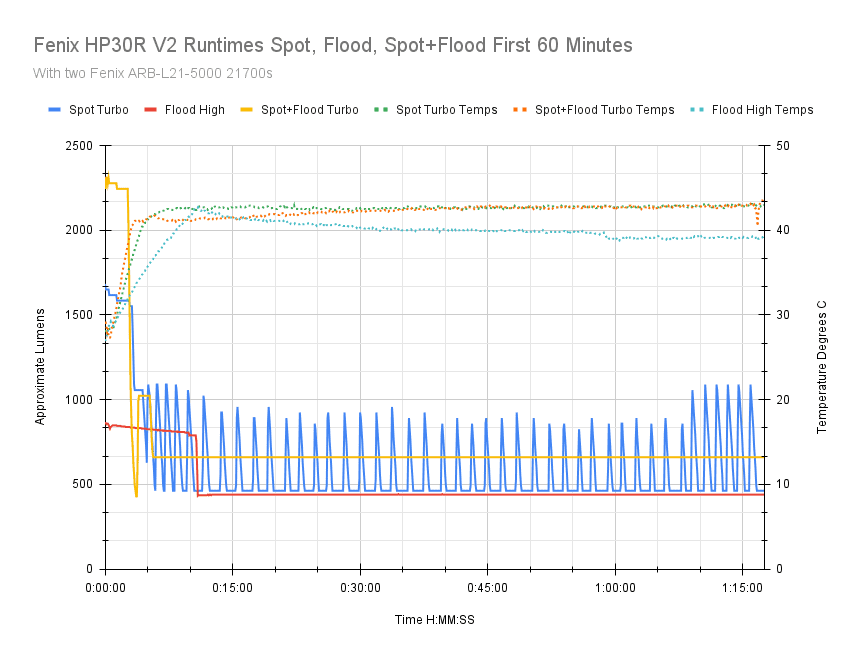
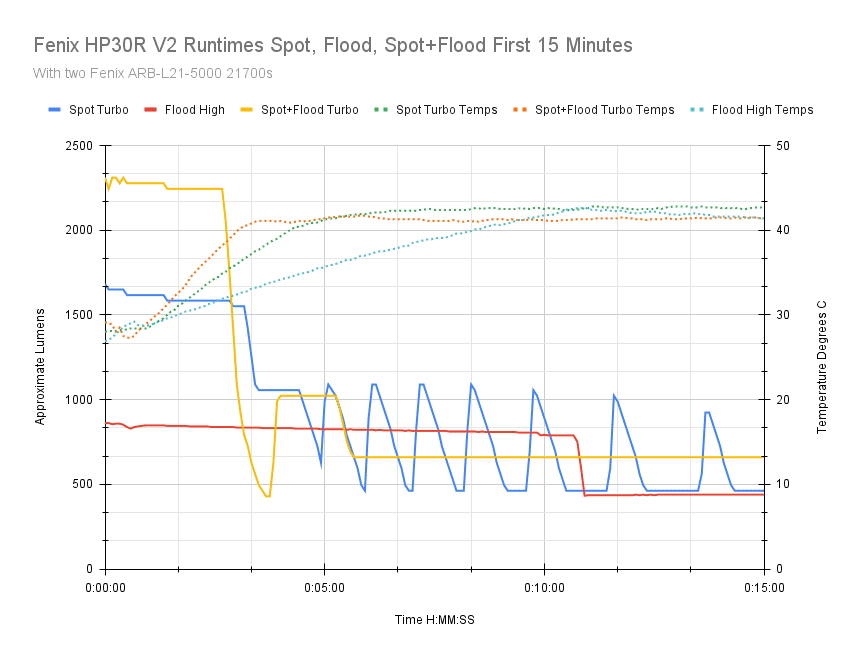
Peak beam intensity and beam distance measurements
About Peak beam intensity: Understanding ANSI FL1 Standards About peak beam intensity The calculated value of distance in meters at which the flashlight produces a light intensity of 0.25 lux. (0.25 lux is about the brightness of a full moon shining on an object). This means that the intensity has decreased so much, it becomes difficult to see darker objects, or objects that don’t reflect light. The columns ‘Meters’ and ‘Yards’ use rounded numbers.The beam distance test was conducted using the Uni-t UT383S luxmeter at a distance of 5 meters. I used the included Fenix ARB-L21-5000 mAh 21700s for the test. Measurements taken at 30 seconds per ANSI spec.
| Mode | Specs | Candela measured | Meters | Yards |
|---|---|---|---|---|
| Spot LED | ||||
| Low | 450 cd | 500 cd | 45 | 49 |
| Medium | 1515 cd | 2025 cd | 90 | 98 |
| High | 6104 cd | 8300 cd | 182 | 199 |
| Turbo | 15,733 cd | 20,225 cd | 284 | 311 |
| Flood LED | ||||
| Low | 76 cd | 75 cd | 17 | 19 |
| Medium | 291 cd | 350 cd | 37 | 40 |
| High | 1513 cd | 2,350 cd | 97 | 106 |
| Spot and Flood LEDs | ||||
| Low | 512 cd | 650 cd | 51 | 56 |
| Medium | 1812 cd | 2375 cd | 97 | 106 |
| High | 7881 cd | 10,925 cd | 209 | 229 |
| Turbo | 17,933 cd | 22,275 cd | 298 | 326 |
The throw figures are coming a bit higher than Fenix’s. This is respectable performance from a headlamp not designed for throw, and nearly 300 meters of throw is more than enough for most tasks, and farther than an unaided eye can see under most circumstances.
Beamshots
Camera settings and distance: Photos taken with my Samsung Note 8 set to 0.3s ISO 200 and 5000K WB. The fence is 40 meters distant. You can see the difference in the different LEDs and reflector configurations.
Beamshots of the following headlamps compared:
- Fenix HP30R v2
- Fenix HM71R (spot and flood modes)
- Fenix HM70R (T-type headlamp spot and flood modes)
- BioLite 800 Pro (spot and flood modes)
- Cyansky HS3R
- Cyansky HS6R (flood and spot modes)













Disclaimer: This flashlight was sent to us for review at no cost by Fenix Lighting US. We have not been paid to review, nor have we been holding back on problems or defects.
Final Verdict
Pros
- Great build quality
- Lots of power available
- Very versatile beam
- Fully regulated output
- Rotary switch UI is very effective
- Very comfortable headband
- Power bank output
- Battery can be remotely mounted
Cons
- Low CRI for the warm white LEDs
- There is a learning curve with the rotary switch
- Heavy
- Output zigzag
Explanation on star ratings:
1: Avoid: a match would be a better choice – 2: Poor: significant defect or issues; almost unusable – 3: Average: some defects or issues; but still usable 4: Good: recommended (minor issues) – 5: Great: highly recommended

4.5 stars: ★★★★⋆
While our star rating provides a reliable indicator, we encourage you to read the full review to make an informed decision based on your own needs and preferences.
Once again (I’m sounding like a broken record) Fenix shows us why they’re a major player in the portable lighting arena. Whether it’s a EDC light, tac light, general purpose, or headlamp, Fenix has something for everyone. The HP30R V2 drives that home even though it’s not a headlamp I’d recommend to everyone. If you need high sustained output, long runtimes, a beam that reaches 200+ meters easily, and reliable performance, and if cost, size, or weight aren’t an issue, then the HP30R V2 is for you.
If you need a general bumping-around headlamp, there are better choices. I really appreciate the high versatility factor with the detachable battery pack, power bank, extension cable, and belt clip. This is a headlamp that can go to the mountains during a snowstorm or spelunking into a damp, dark cave just fine. It’s well-designed and easy to live with for a big headlamp as well. The headband is comfortable, and I think that helps it feel smaller than it really is when I wore it.
The real gem here is the rotary switch UI. Fenix did a great thing here and went with probably the best alternative to a traditional button. It’s intuitive to use and works with gloved hands perfectly, and no guessing about which mode you’re in, or what brightness setting either. I will say there’s a learning curve to it, but it’s a short one.
If I had to nit-pick this one, it would have been nice to see the 90 CRI or the 80 CRI XP-G3s instead of the 70 CRI ones, but I get it…output and efficiency over nice CCT. That said, they are nicely neutral white. I do appreciate having mode memory with headlamps, but I’ll make a concession here since the rotary switch works so well. While the HP30R V2 is certainly not a budget light, it’s not unreasonable either for what it is. Should you buy one? Well, if you’ve got the money and you need one of the better-performing and output sustaining headlamps on the market, then pick up the HP30R V2. 4.5 stars for the Fenix flagship headlamp!
Buy your Fenix HP30R V2 with a discount
Get 10% off every purchase at Fenix Lighting US, by using our exclusive 1lumen discount code: 1lumen10
1lumen selects and reviews products personally. We may earn affiliate commissions through our links, which help support our testing.